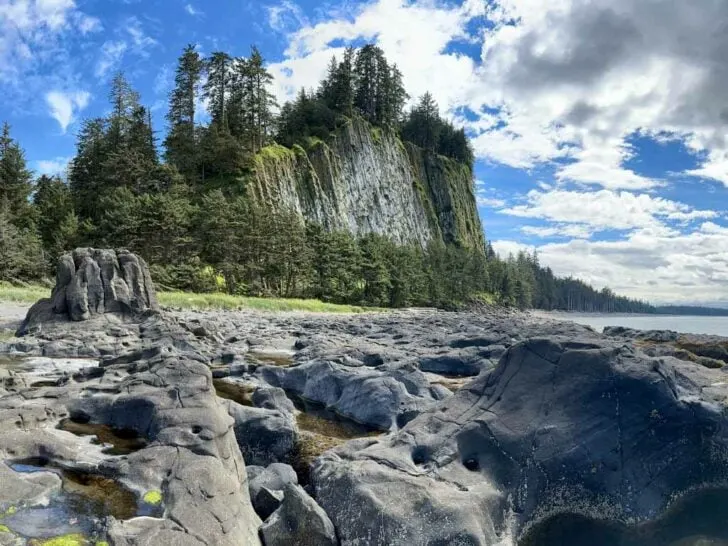For years I’ve been dreaming of going to Haida Gwaii, the remote archipelago off the northwest coast of British Columbia. I had heard that the scenery was incredible, there was lots of wildlife, and the Indigenous Haida art and culture were worth seeing.
Now that I’ve been to Haida Gwaii, I can’t wait to go back. Everything I had heard about it was true… and somehow it was even more special than I had thought.
Since it’s a long way to go, planning a trip to Haida Gwaii can be intimidating. But it’s definitely worth the trip! In this post, I’ve got everything you might ever need to know about these magical islands.
This Haida Gwaii guide includes:
- Haida Gwaii basics: Where is it? Why visit? Best time to go? What’s the weather like? And lots more.
- Map of Haida Gwaii: It includes all the places I mention in this post.
- Best things to do in Haida Gwaii: Over 25 villages, parks, hikes, Indigenous sites, museums, activities and attractions.
- How to get to Haida Gwaii: Info on ferries and flights.
- Getting around on Haida Gwaii: Driving tips and info on car rentals, taxis, shuttle buses, and ferries.
- Hotels and B&Bs: My picks for where to stay all around the islands.
- Restaurants: Where to eat in each town or village.
- Tips for visiting Haida Gwaii: What I wish I had known before my trip
This is a sensitive wilderness area. Learn how to Leave No Trace to keep the wilderness wild. Make sure you are prepared by bringing the 10 Essentials. Get ready for adventure with this checklist of things to do before every hike.
Hey there: Thanks so much for BC Ferries for hosting me on this trip. All opinions in this post are my own. Some of the links in this post are affiliate links, which means I earn a small commission at no cost to you. Thanks for supporting my website! -Taryn
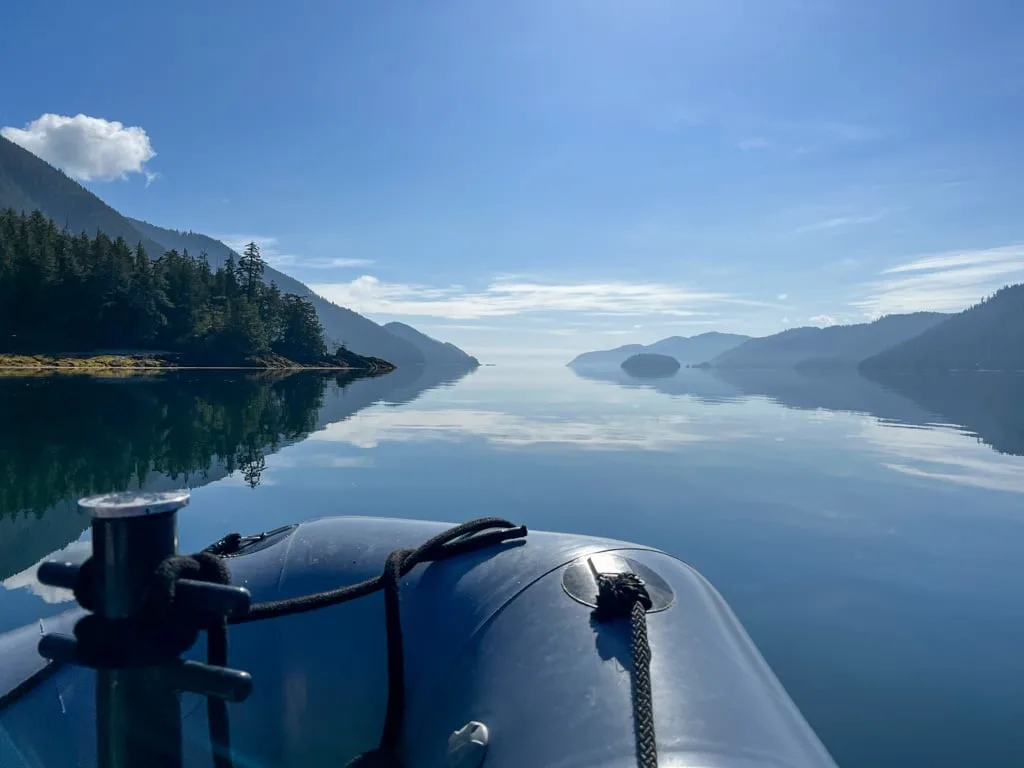
Haida Gwaii Basics
What’s with the name?
In the language of the Haida, the local Indigenous people, Haida Gwaii means “Islands of the Haida people.” It is pronounced “hy-dah gwhy”.
From 1787 to 2010, the islands were officially called the Queen Charlotte Islands, often nicknamed “the Charlottes”. You will still find this name on some maps.
Where is Haida Gwaii?
Haida Gwaii is located about 100 kilometres off the west coast of British Columbia, near the border with Alaska. There are two main islands: Graham Island (where most people live) and Moresby Island, along with about 400 smaller islands.
Why Visit Haida Gwaii?
Some of the reasons to visit Haida Gwaii include incredible Indigenous culture and art, a unique ecosystem, which has been called Canada’s Galapagos, opportunities to view wildlife (including bears and whales), old-growth forests, and great hiking, camping, kayaking, and fishing. I’ve got lots of info on all of this below.
How Long to Spend in Haida Gwaii
I would recommend spending a week in Haida Gwaii. That gives you enough time to see the highlights and to take a boat tour to Gwaii Haanas National Park. If you want to plan a shorter trip, 4-5 days would be the bare minimum. I spent 10 days on Haida Gwaii and honestly, I wish we had stayed for a few more days.
Best Time to Go to Haida Gwaii
The best time to go to Haida Gwaii is between May and September. Those are the months when the weather is nicest and most tours are running. If you visit outside of those months, you will find many businesses are closed.
While Haida Gwaii is never too crowded, it is much less busy in May and September than it is in June, July, and August. Most visitors come in the summer months. I went in June and we enjoyed mostly sunny weather. As well, most of the attractions were pretty quiet.
If you want to enjoy the best bird watching and whale watching, May and September are great since that’s when the birds and whales migrate through the islands. September is also a good month for wildlife watching as the salmon spawning season begins.
Weather in Haida Gwaii
Haida Gwaii has a coastal climate and is in northern British Columbia.
In general, it is fairly rainy. The driest months are May, June, and July. August and September are also relatively dry. October through February are very wet with 150-175 mm (6-7″) of rain each month. You should expect rain on any trip to Haida Gwaii, even in the summer.
July and August are the warmest months with daily temperatures of 10-18°C (50-64°F). May, June, and September are a little cooler. In the winter (November to March) temperatures are close to freezing – typically 1-7°C (34-45°F).

Cell Phone Coverage
You will find cell phone coverage in all of the major towns in Haida Gwaii and along most of the east coast of Graham Island. In many places, cell phone signal strength is too weak to use data. However, as soon as you leave the towns, you will likely lose service.
Indigenous Context
The Haida people have lived on Haida Gwaii since time immemorial. Pre-contact, there were tens of thousands of Haida spread over several dozen towns. When smallpox and other infectious diseases were introduced by European colonizers (perhaps deliberately), the population plummeted to around 600.
Today the Haida people make up half of the 5000-strong population of Haida Gwaii. Most Haida in Haida Gwaii live in Skidegate and Old Masset. There are also about 2,500 Haida living elsewhere in BC. There are also Haida villages in southern Alaska, another part of their traditional territory.
The Haida Nation collectively holds Hereditary and Aboriginal Title and Rights to Haida Territories and the government structure of Haida Gwaii incorporates the Council of the Haida Nation.
Haida culture permeates the entire region, even in areas dominated by settlers (non-Haida people). The Haida word for thank-you, haaw’a (pronounced how-ah), is something you will hear everyone saying. You should say it too!
Haida Gwaii and Gwaii Haanas National Park are one of the best places to experience Indigenous culture in Canada.
The Haida Gwaii Pledge
To help visitors respect this special place, the Haida Nation developed the Haida Gwaii Pledge. All visitors are encouraged to read and sign the pledge.

Haida Gwaii Map
To help you find your way around, I made this custom Google Map of Haida Gwaii for you. It includes every single place I mention in this post.

Best Things to Do in Haida Gwaii
Gwaii Haanas National Park Reserve
The entire southern part of Haida Gwaii is protected in Gwaii Haanas National Park Reserve. The park’s name means “Islands of Beauty” in the Haida language. Containing over 100 islands, the national park is known for its incredible scenery, wildlife, and Indigenous culture.
Since the park is only accessible by water, the best way to see it is on a tour. You can book kayak, sailing, or motorboat tours. Most tours are 3-7 days long as it’s a big area to cover. But you can book single-day tours that cover a few of the main sites. Be sure to book tours well in advance as they sell out.
I did a four-day tour with Moresby Explorers. We saw all of the major sites in the park and stopped and lots of remote beaches. I definitely recommend them.
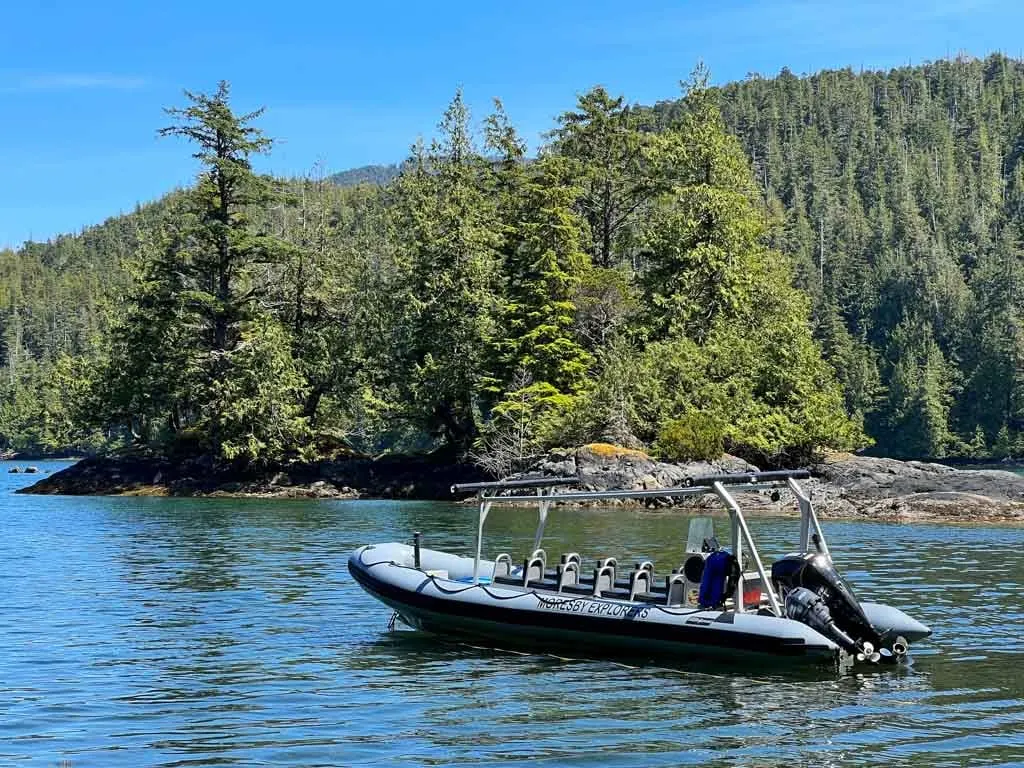
Some of the most well-known and popular sites in Haida Gwaii are in Gwaii Haanas National Park. These Haida Heritage sites are protected by Haida Watchmen, members of the Haida Nation who provide important historical and cultural context.
For more info, check out my huge guide to Gwaii Haanas National Park. The main attractions in Gwaii Hanaas National Park include:
Wildlife Watching
Gwaii Hanaas National Park is known for its incredible wildlife. Grey and humpback whales migrate through the islands and orcas (killer whales), Minke whales, dolphins, porpoises, seals, and sea lions are year-round residents.
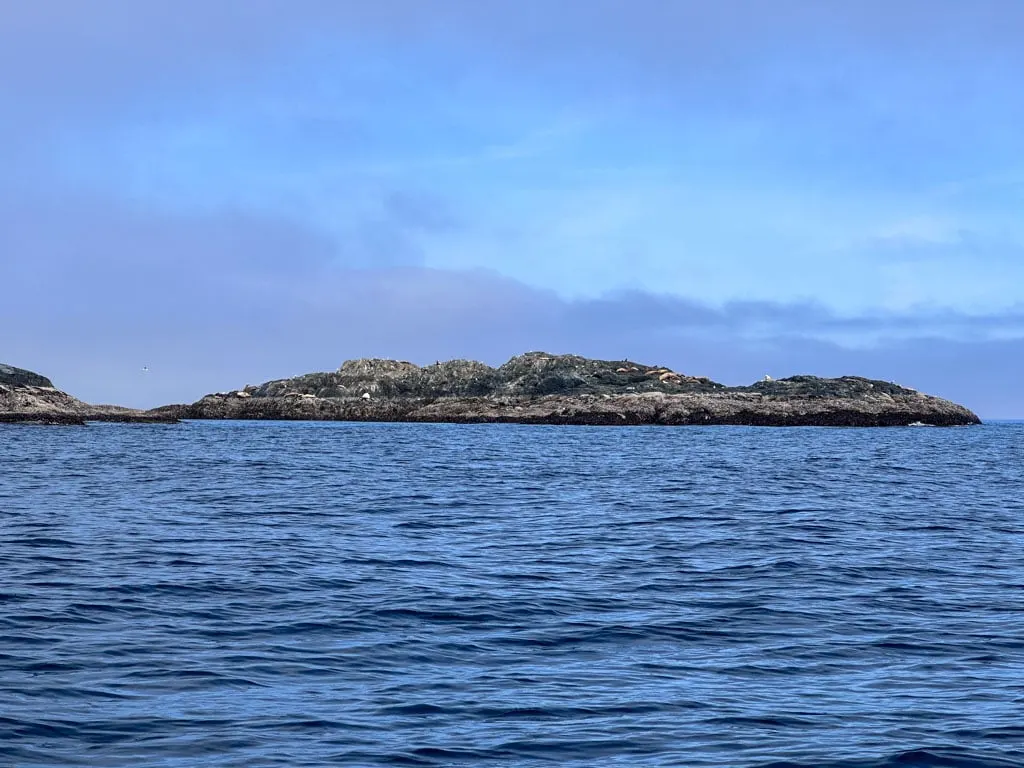
Haida Gwaii also has its own sub-species of black bears (Ursus americans carlottae). It’s a bit bigger than black bears in the rest of British Columbia since it lives on a high-fat diet of salmon and shellfish. Spotting black bears on the beaches is common.
The National Park is also a great place for bird watching. Parks Canada says about 1.5 million seabirds nest in the park. On my trip, we spotted lots of bald eagles, ancient murrelets, black oystercatchers, cormorants, and pigeon guillemots. But the highlight was a pair of tufted puffins!
SGang Gwaay
Located on Anthony Island near the southern tip of Gwaii Hannas National Park, SGang Gwaay is a UNESCO World Heritage Site. This Haida Village site still has many standing monumental poles (often incorrectly called totem poles), as well as the remains of many long houses.
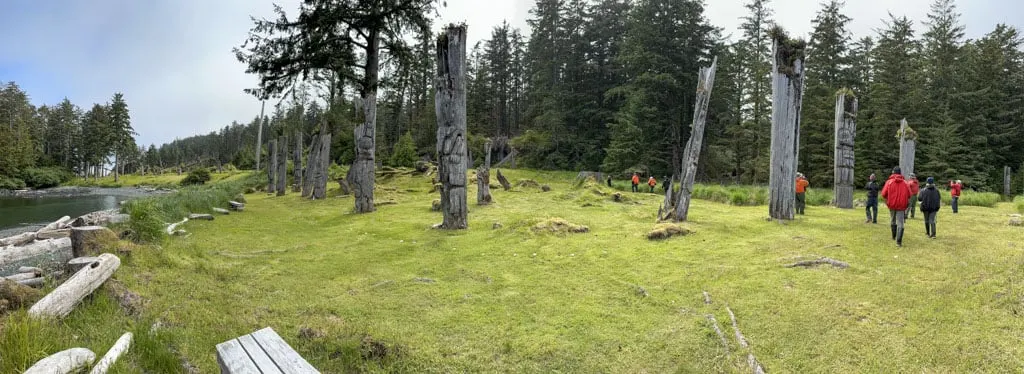
K’uuna/Skedans
This is the northernmost of the Haida Village sites, making it the easiest to visit. It includes remains of long houses as well as a few carvings and poles.
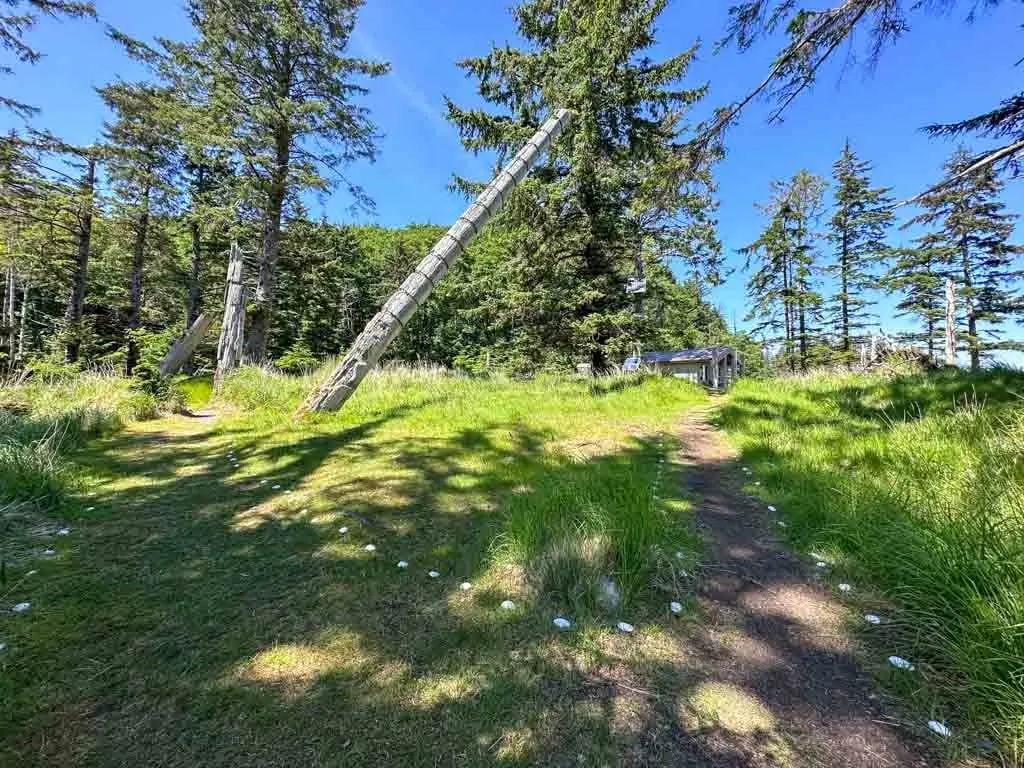
T’aanuu (Tanu)
This Haida Village site has a few long house remains. It was low tide when we visited, and the watchmen pointed out an old octopus farm that the Haida had cleared out of the rocks. It is the ancestral village of famous the Haida carver, Bill Reid.
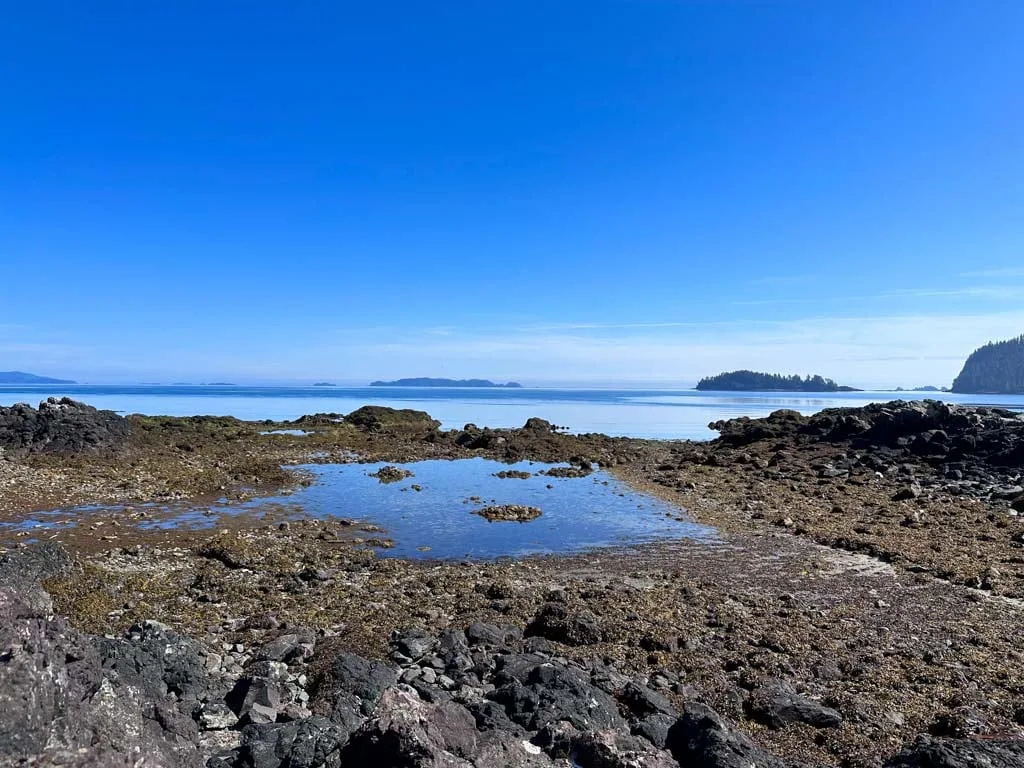
Hot Springs Island
Known as Gandll K’in Gwaay.yaay in Haida, these hot springs have been used for generations by the Haida people. The pools mysteriously drained in 2012 following an earthquake, but today they are back and flowing into new pools. Bring your swimsuit so you can soak!
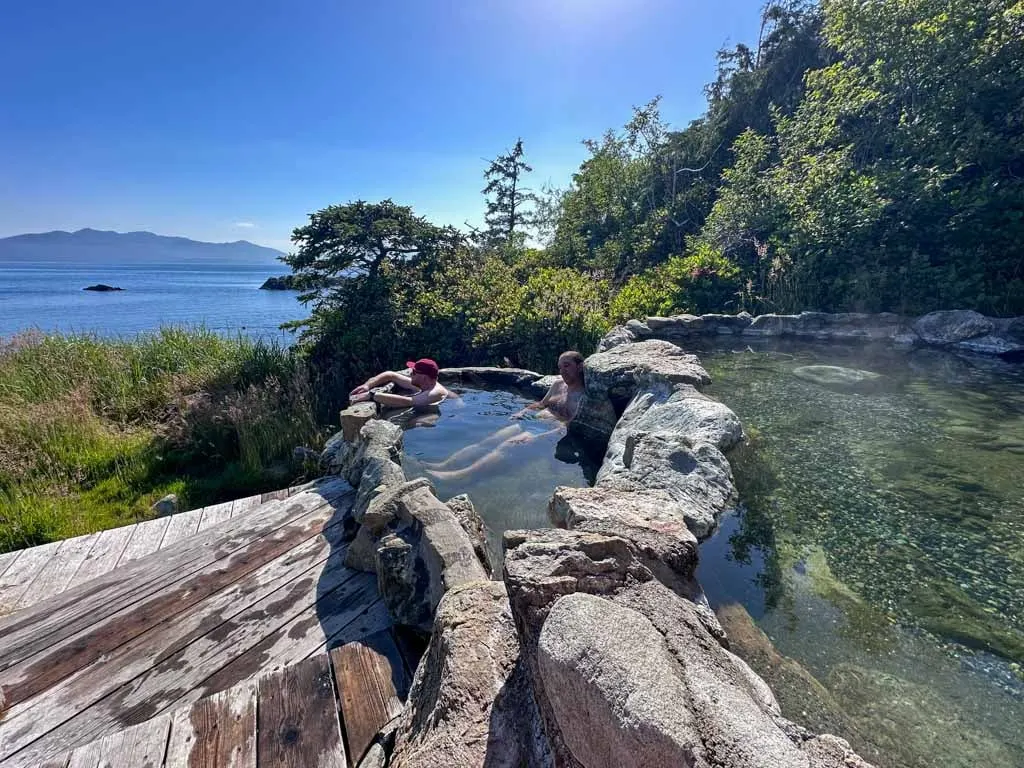
Windy Bay
Called Hlk’yah GawG̱a in Haida, this is an important site in the Haida protest movement that led to the creation of Gwaii Haanas National Park. The site includes a huge old-growth Sitka spruce and a modern monumental pole, raised to mark the anniversary of the founding of the park.
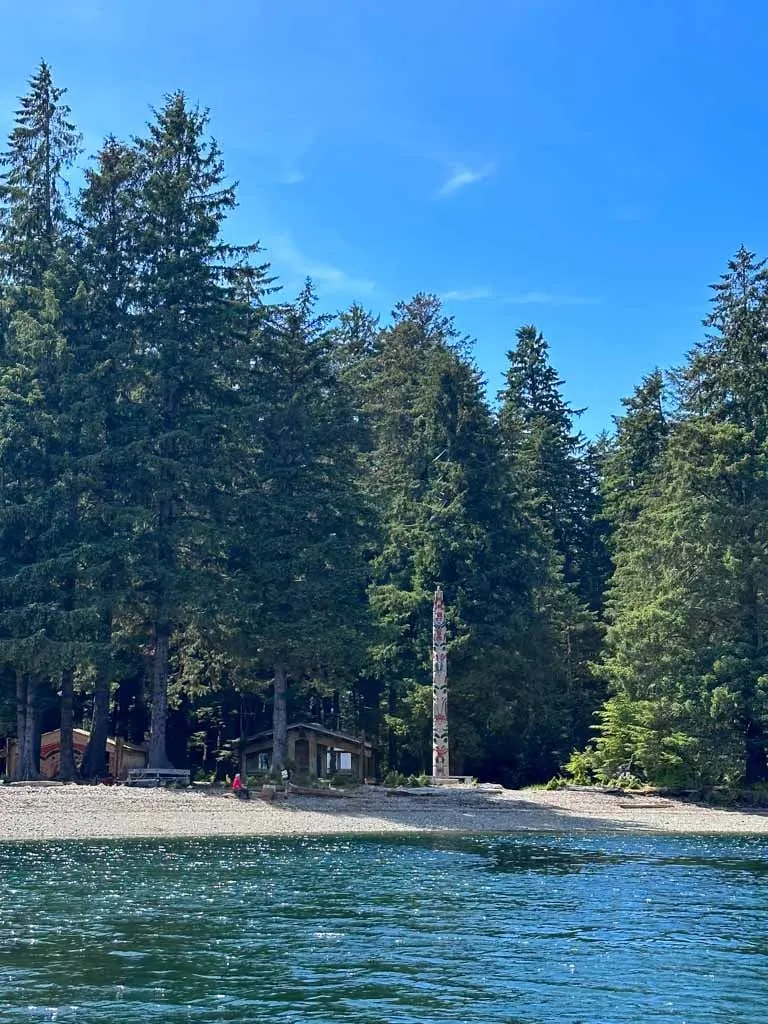
Haida Gwaii Museum
The huge Haida Gwaii Museum is a must-see for any visitor. Designed to look like a series of longhouses in a traditional Haida village, the sprawling museum is located inside the larger Haida Heritage Centre complex. It has wonderful displays about Haida history and culture.
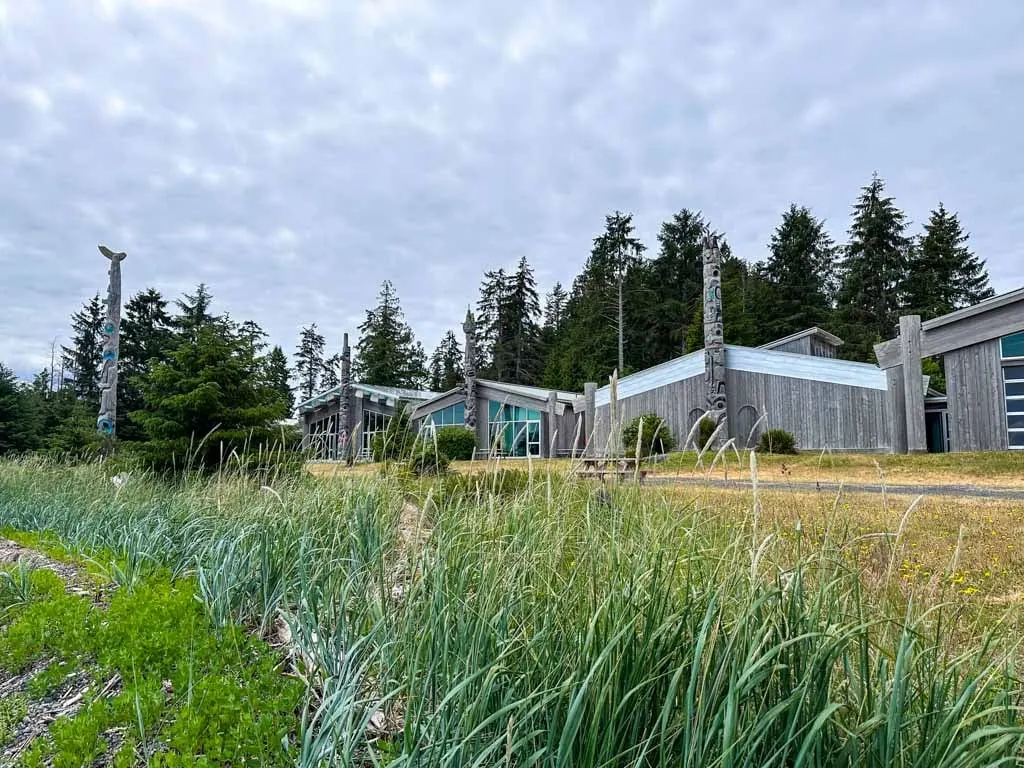
You can find lots of historical and contemporary carvings, art, and poles, some of which have been returned to the Haida after being looted from ancient village sites and taken to museums around the world.
Plan to spend at least a few hours here. Some visitors prefer to visit the museum first, to give context to the rest of their time on Haida Gwaii. We went to the museum on our last day, and to me, it felt more powerful to see some of the art and historical displays in person after hearing about them earlier in our trip. That way we knew which pieces were most significant.
Naikoon Provincial Park
Naikoon Provincial Park covers the northernmost part of Haida Gwaii. The huge park has lots of hiking trails, beaches, and rainforests. A few sections of the park are accessible by car. But to get to most of the park you will need to hike.
Here’s a rundown of the park highlights:
Tow Hill and the Blowhole
Called Taaw Tldáaw in Haida, Tow Hill rises 125 meters above the otherwise flat coastal marsh of Naikoon Provincial Park. On the seaward side of the hill is a spectacular cliff with volcanic rocks. You can follow a short but steep hiking trail to the top of Tow Hill for spectacular views.
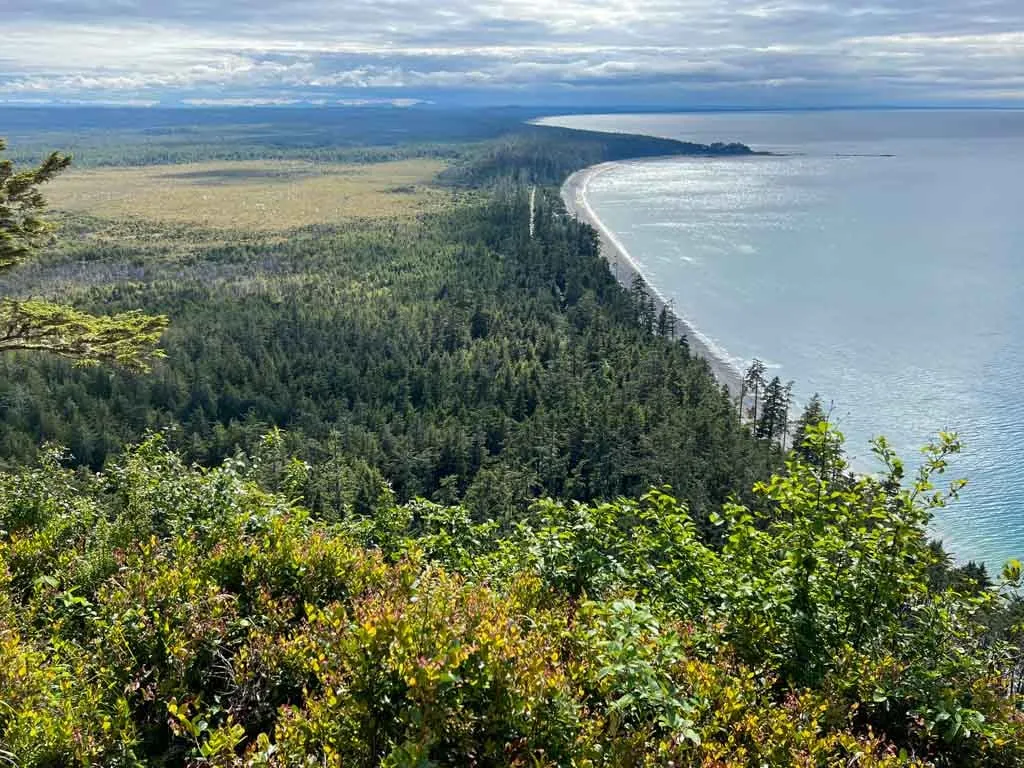
Tow Hill/Taaw Tldáaw is an important place in Haida culture and history. Plaques along the trail explain its significance.
You can also follow a flat and easy trail to the beach to look up at Tow Hill from below. This is also where you will find the Blow Hole. When the tides and waves are right, water splashes up from a chasm between the rocks. Tip: Go on a rising tide when there is moderate swell.
Read my Tow Hill hiking guide for all the details.
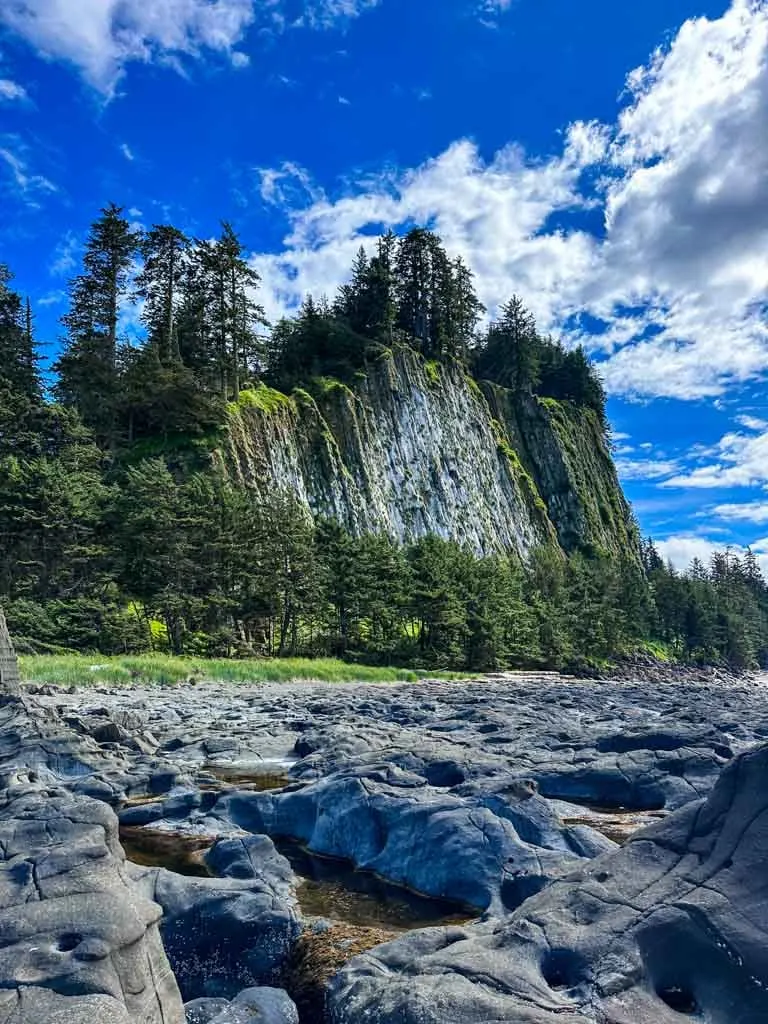
Hiellen Village
Hiellen Village isn’t actually in Naikoon Provincial Park, but it is next to Tow Hill and surrounded by the park. Today the campground and longhouse-style cabins are operated by the Haida Nation. The site is a historical Haida village and was a battleground for conflicts between the Haida and the Nisga’a.
The village is the starting point for hikes or drives on North Beach (see below). It also has a spectacular modern monumental pole.

North Beach and Rose Spit
Sandy North Beach (Gaatsguusd) stretches for about 10 kilometres north of Tow Hill to Rose Spit, which is the northernmost part of Haida Gwaii. You can hike, bike, ATV, or drive along the sand out to the Rose Spit Ecological Reserve, which protects a unique dune ecosystem.
You will see a lot of locals driving on the beach here. Don’t try it in a rental car, as you will violate your rental agreement. And if you are in your own car, be careful as it is easy to get stuck.
As well, the park has clear guidelines on where you can drive to protect the ecosystem. You must drive below the high tide line or on designated roads.
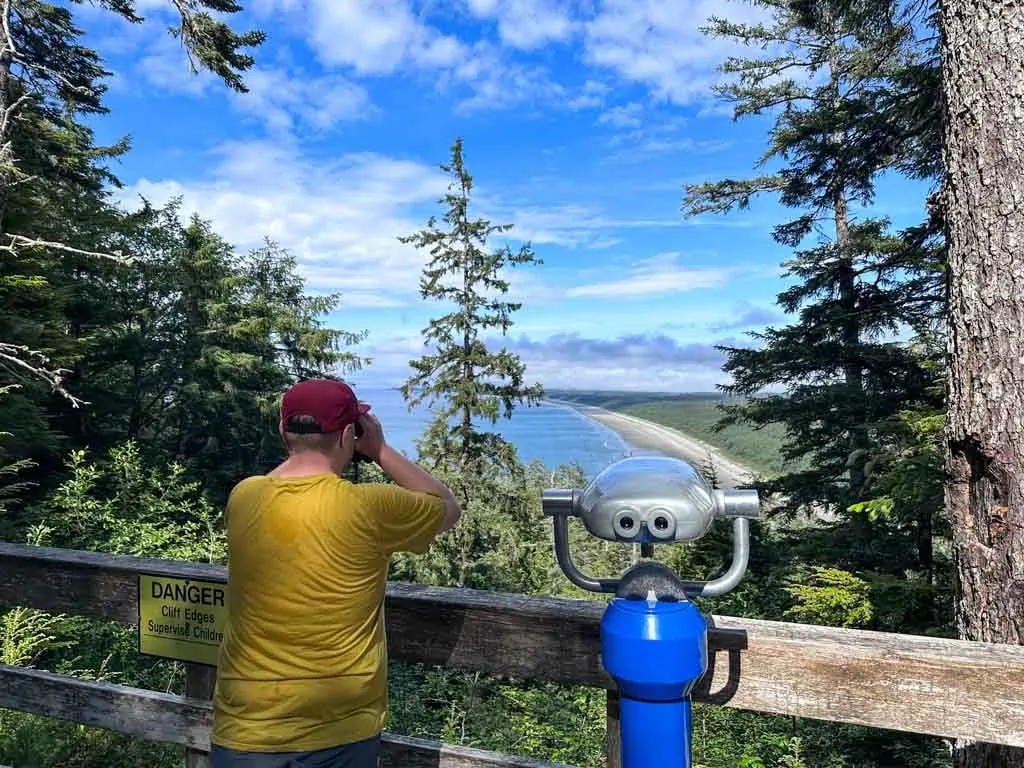
Rose Spit (Kadls Kun) is also a very important Haida site. In the Haida creation story, a raven opened a clam shell to release the first Haida at Rose Spit. This story is depicted in Haida Carver Bill Reid’s famous sculpture, The Raven and the First Men, on display at Vancouver’s Museum of Anthropology.
Agate Beach
When I was planning my trip to Haida Gwaii, lots of people told me I had to camp at Agate Beach and it did not disappoint. The steep gravel beach has incredible views of Tow Hill, the sunset, and even glaciers in Alaska (which are best seen through binoculars).
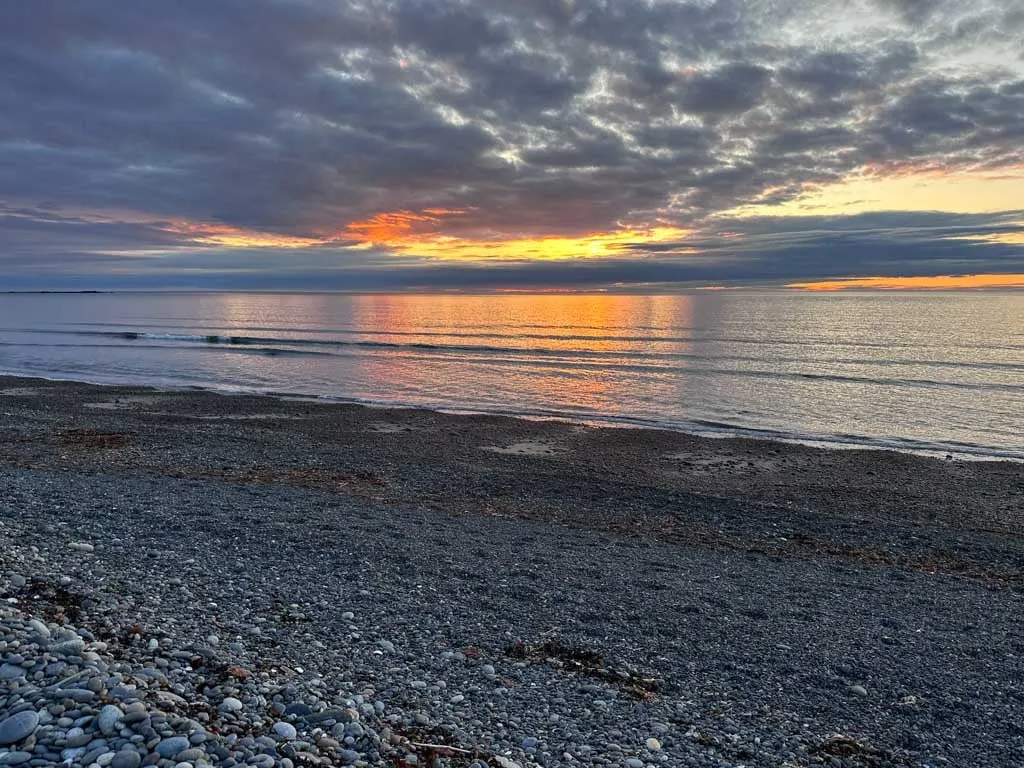
It’s also a popular spot for crab fishing. We met lots of locals and regular visitors who were wading through the surf at low tide, scooping up crabs with nets. I had never seen this style of crab fishing before (I’ve only ever used a trap), and wished we had bought gear to try it out.
Most of the campsites are right at the edge of the beach. If you don’t plan to camp, it’s worth visiting for a picnic.
East Beach, Cape Ball, and Cafe Fife
If you think North Beach is long, then check out East Beach. It’s over 70 kilometres long! The beach stretches between the village of Tlell and the tip of Rose Spit. The easiest way to see it is to hike the first section to the Pesuta Shipwreck (see below) or beyond to Cape Ball where there is a cabin and backcountry campsite.
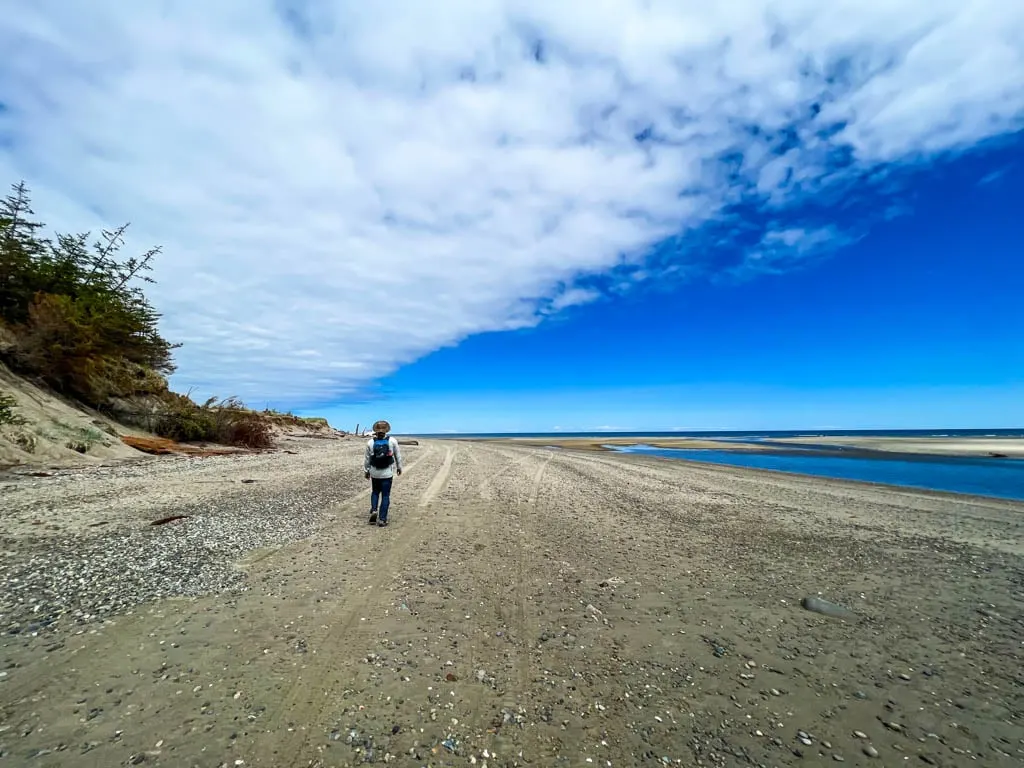
But you can also hike the entire thing on the East Beach Trail, a 90-kilometre route that starts in Tlell, goes around Rose Spit, and then finishes at Tow Hill.
You can also reach East Beach by hiking the Cape Fife Trail across the interior of Naikoon Peninsula from North Beach near Tow Hill to Cape Fife on East Beach. There is a rustic cabin and campsite here too.
Pesuta Shipwreck
The hike along the Tlell River to East Beach and the Pesuta Shipwreck Trail is one of the most popular trails in Haida Gwaii. The flat hike has beautiful scenery and ends at a spectacular shipwreck, the remains of a log barge that was wrecked in 1928.
Read my Pesuta Shipwreck Trail guide for all the details.

Villages in Haida Gwaii
Haida Gwaii’s population is fairly small and is clustered into a few villages. You will likely end up visiting a few of them since that’s where you can find groceries, restaurants, gas stations, and hotels. But there are other things to see too.
Here’s a quick overview of what to see in each of Haida Gwaii’s Villages:
Sandspit
Sandspit is the only town on Moresby Island, the southern of Haida Gwaii’s two major islands. This is where you will find the Sandspit Airport with direct flights to Vancouver. It’s also the starting point for many tours to Gwaii Hanaas National Park. In Haida, Sandspit is known as K’il Kun.
With a population of about 300, there isn’t much going on in Sandspit. However, they do have a small grocery store, a gas station, and a golf course. The Sandspit Visitor Centre at the airport is also a helpful stop if you’ve just arrived.
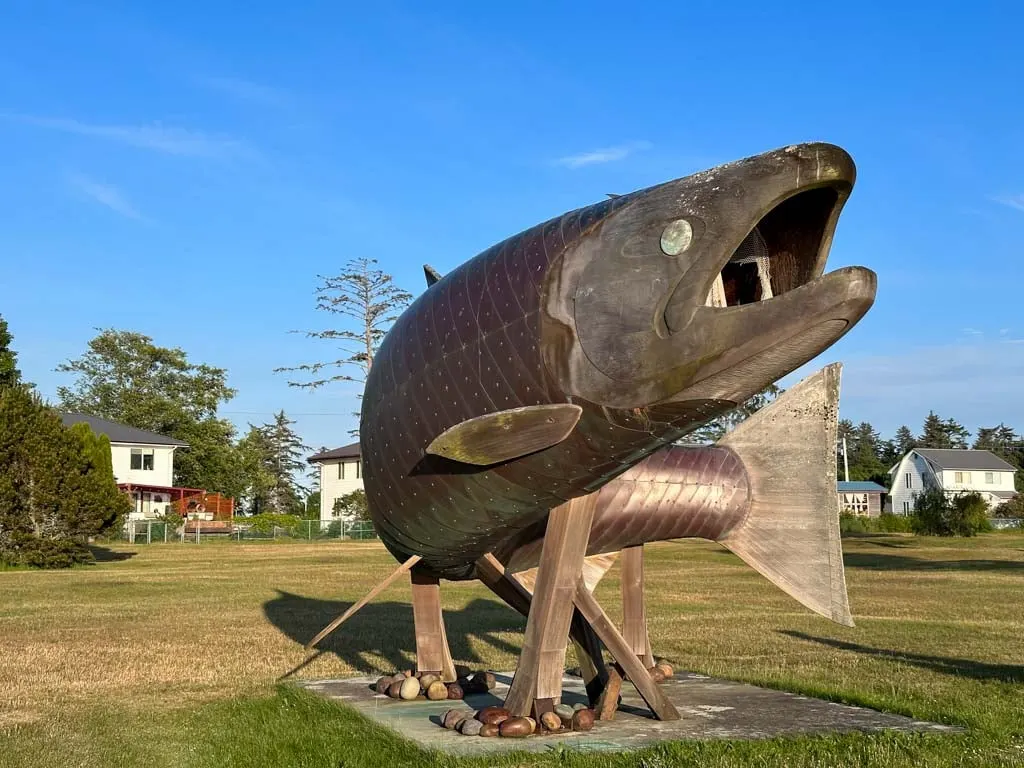
The long beach is also great for a walk at low tide. Don’t miss the unique wood and cedar sculpture of a salmon near the airport. You can also follow the Spit Trail all the way around the perimeter of the airport.
On the drive to Sandspit from the ferry landing, stop at Onward Point to walk through the trees to a whale viewing platform.
Daajing Giids (Queen Charlotte City)
With a population of about 1000, Daajing Giids is the largest town in Haida Gwaii. The town was known as Queen Charlotte City from the 1880s until 2022, and you will still find that name on some maps and signs.
But it reverted to its Haida name as part of the process of restoring traditional names on Haida Gwaii. Pronounced, “daw-jean geeds”, the name means cedar dance hat.
Daajing Giids has lots of services for visitors including a grocery store, gas station, and restaurants. If you are looking for art and gifts, head to Funk It. The visitor centre also has lots of helpful info as well as a good gift shop. I also loved looking at their big relief map of Haida Gwaii.
Be sure to enjoy the view from outside the visitor centre and check out the whale sculpture. Or head a few minutes west from town to Haydn Turner Park where you can follow a short trail through the forest to the beach.
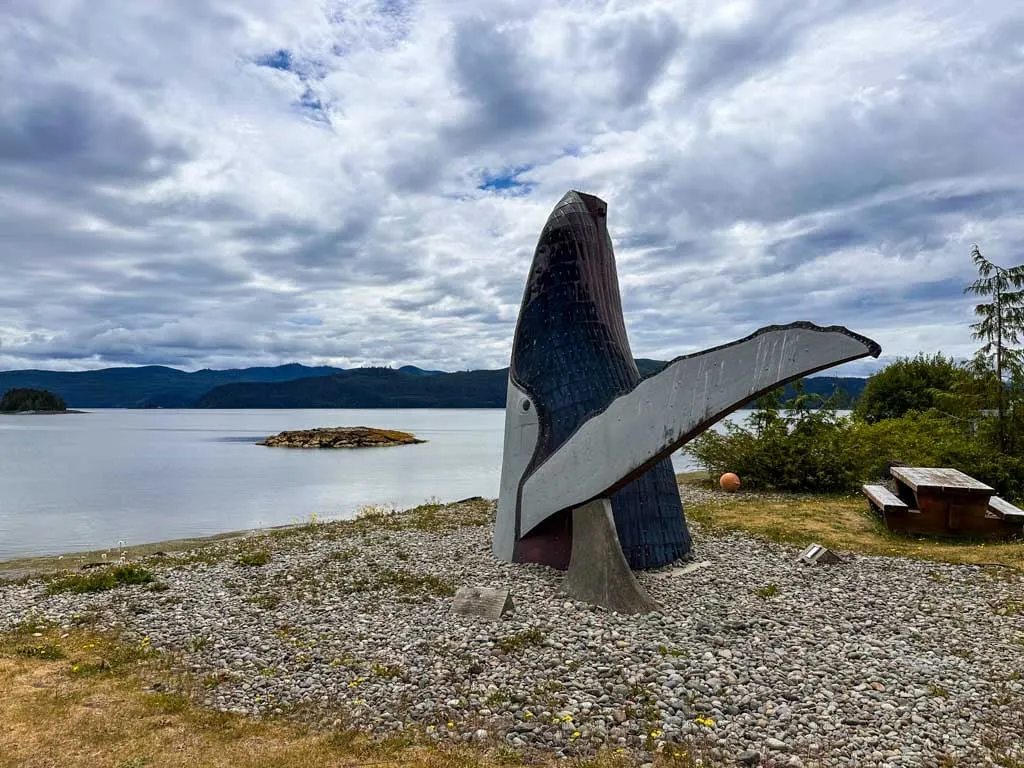
Skidegate
Skidegate (HlGaagilda) is a large Haida community with a population of about 850. The grocery store and gas station are on the highway, but most of the village is tucked away between the highway and the ocean.
The village has a forest of monumental poles, which are neat to see. There is also a great gift shop called Longhouse Gift Shop.
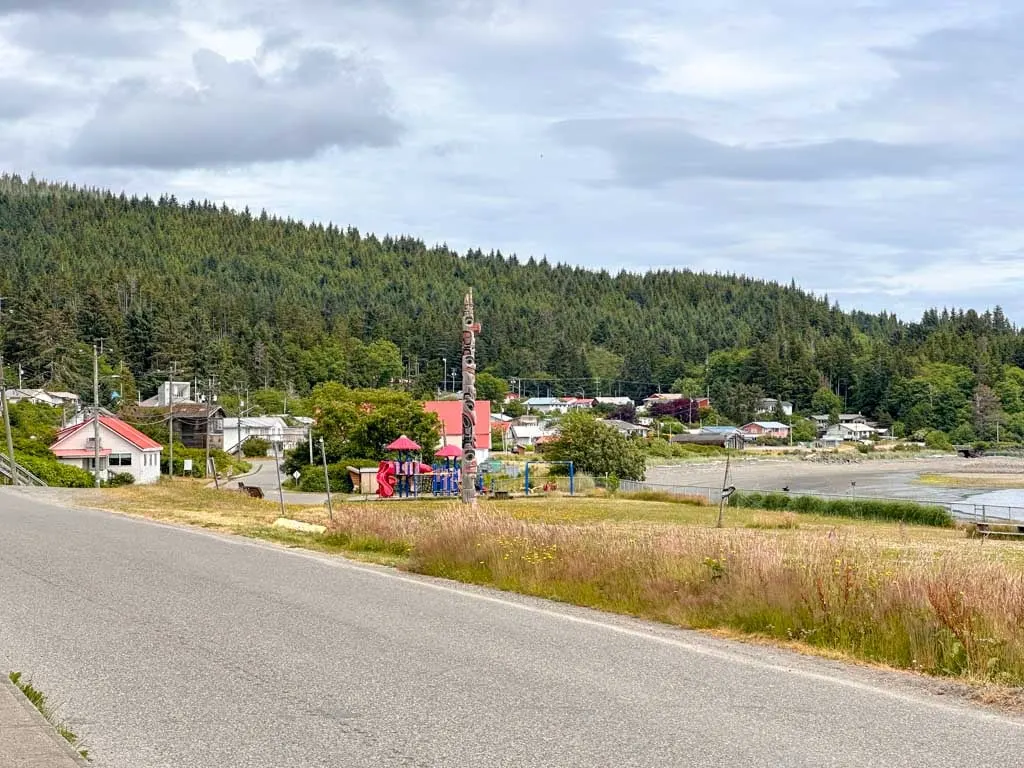
When visiting Haida villages such as Skidegate and Old Masset, be respectful. Don’t take pictures without asking, especially pictures of people. Keep in mind that many monumental poles are memorial poles, erected to mark graves, and photography may not be appropriate.
The Haida Gwaii Museum is located just west of the village and the BC Ferries dock for ferries to Prince Rupert and Moresby Island is a few minutes past that at Skidegate Landing (GuhlGa Llnagaay).
Tlell
Unlike the other villages in Haida Gwaii, Tlell (spelled Tll.all in Haida) doesn’t really have a town centre. Instead, it is a cluster of houses, farms, and artist studios that spreads over a few kilometres close to the coast and the Tllel River. It has a population of about 180 people.
Tlell has a small store/cafe with limited hours, but no other services. The village is known for the Edge of the World Music Festival in August.
Tlell is at the southern end of Naikoon Provincial Park, so you will find the starting point for the Pesuta Shipwreck and East Beach hikes here along with the Misty Meadows Campground.

Port Clements
Located on the calm tidal waters of Masset Inlet, Port Clements is Haida Gwaii’s main logging town. It has a population of about 280 and has a grocery store, gas station/cafe, and a pub. In Haida, Port Clements is called Gamadiis.
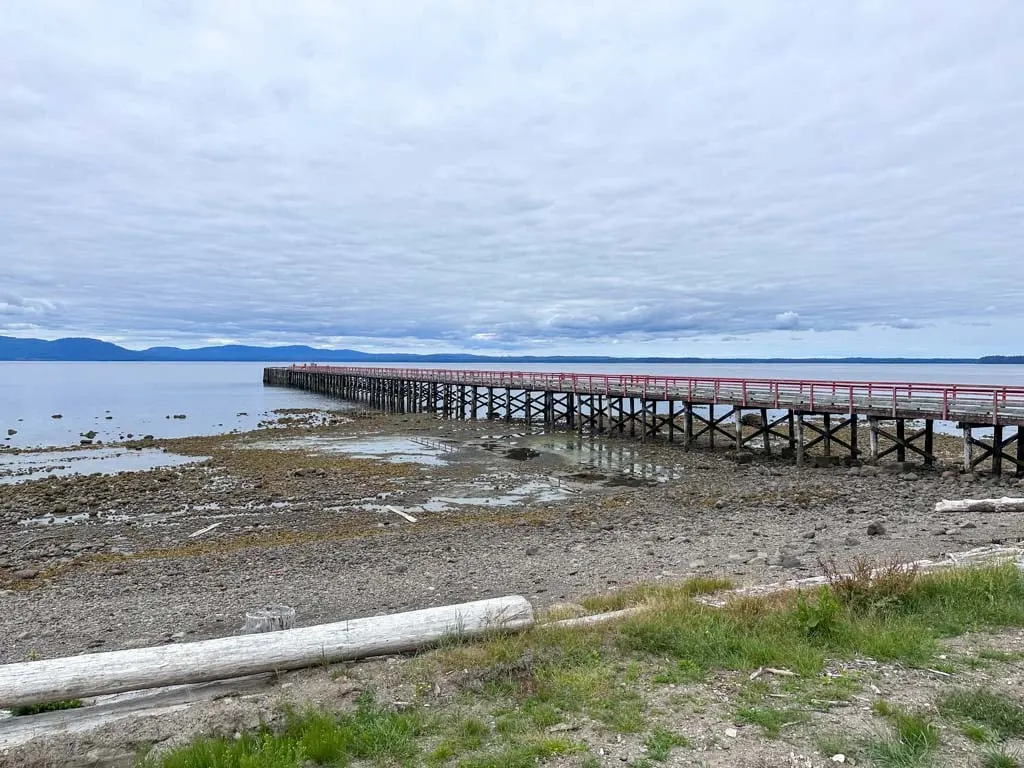
The Port Clements Historical Society museum has a huge display of old logging machines on their grounds that you can visit anytime. Be sure to walk behind the building to check out the view of the harbour.
They also have a small museum building with lots of historical gadgets. They also have exhibits about the famous Port Clements white raven, an albino bird, and the Golden Spruce (see below).
Masset and Old Massett
Masset and Old Massett are two villages set side-by-side at the northern end of Haida Gwaii. Old Massett (Gaw Tlagee) has a population of about 550 and is a Haida village. Masset is a settler village and home to about 800 people.
Masset was a military base during WWII and the Cold War. Today it has an airport as well as a grocery store, gas station, and lots of businesses. They also have a small museum, the Dixon Entrance Maritime Museum, but it wasn’t open on the day I visited.
Old Massett is a few minutes northwest of Masset and like Skidegate, has a ton of monumental poles. Remember to be respectful when visiting and take photos ethically. Old Masset also has several gift shops and artist studios. We stopped at Sarah’s Haida Arts and Jewellery. We wanted to stop at Gin Kuyaas Haida Art, but it was closed the day we visited.
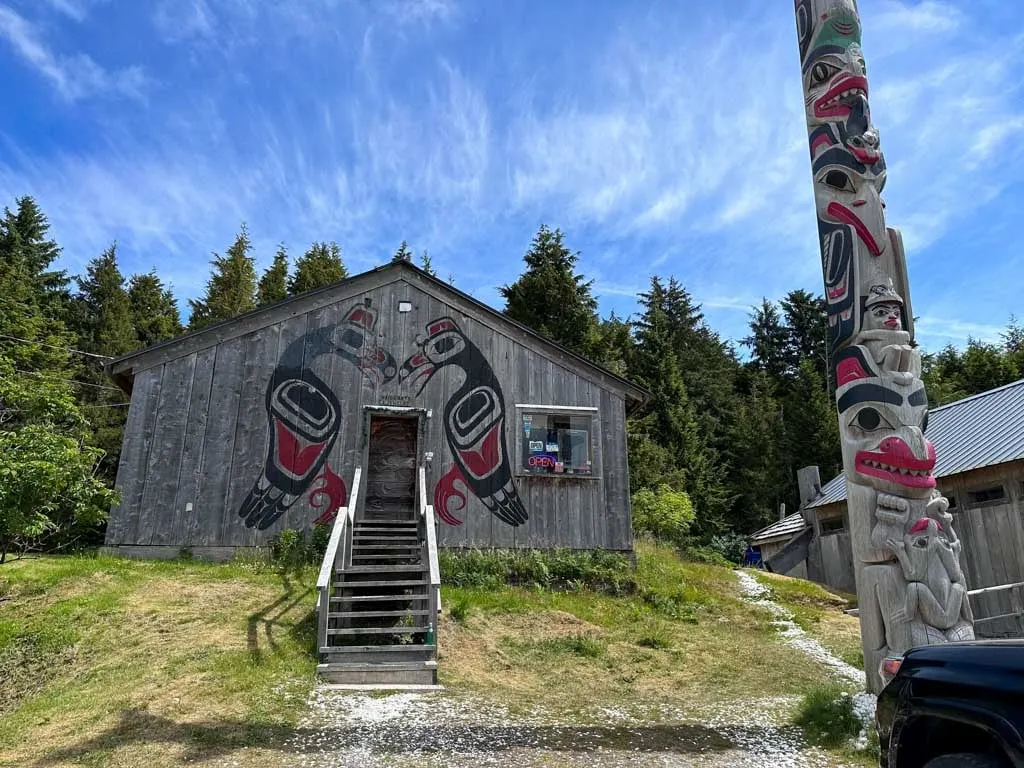
Farmer’s Markets
Since Haida Gwaii’s artists and farmers are so spread out and have limited opening hours, the best way to shop for local goods is to visit a farmer’s market. As of 2023, the market schedule is as follows:
Sandspit: Sundays from 11am to 1pm, June to early September
Daajing Giids: Saturdays 11am to 2pm, year-round
Tlell: Sundays from 11am to 2pm, May to early October
Masset: Fridays from 11am to 2pm, year-round

Spirit Lake Trail
The Spirit Lake Trail is a short and easy hike near Skidegate. In Haida, it is called GuuhlGa Siiwaay K’yuu. There is a beautiful carving at the entrance, which tells the story of a spirit (‘waasguu or wasgo) who lived in the lakes.
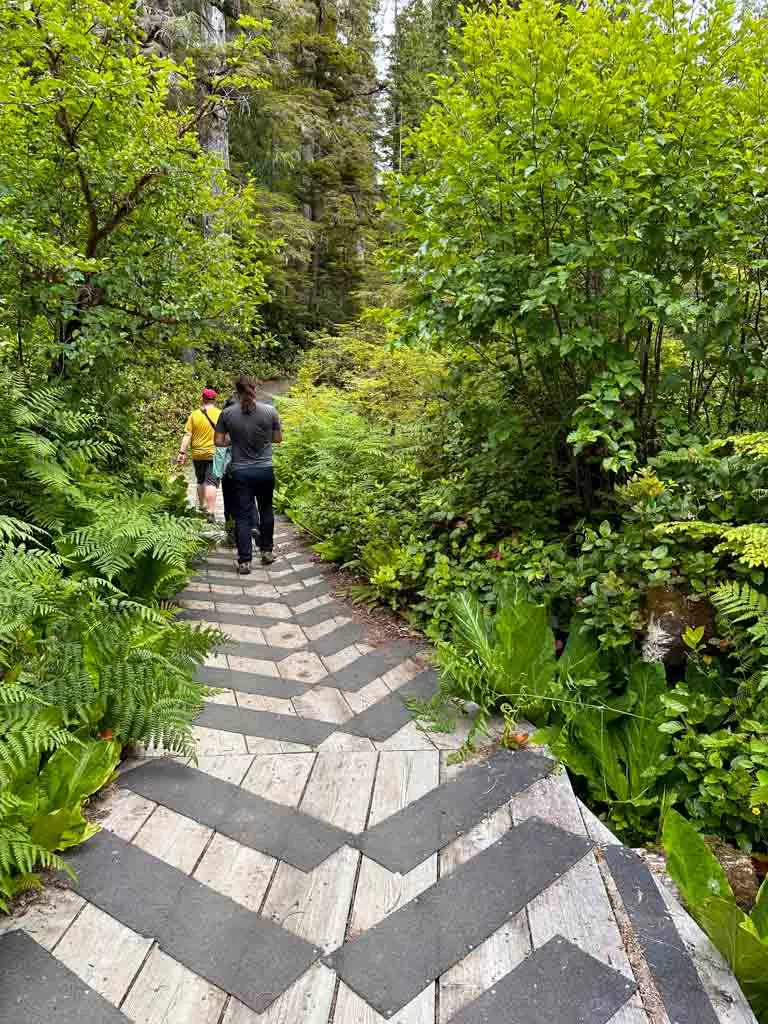
The trail makes loops around two lakes. There are interpretive signs along the way explaining the cultural and spiritual significance of plants and animals.
There are also several culturally modified trees where the Haida harvested cedar bark or made test holes in trees to see if they would make good canoes or monumental poles.
Balance Rock
One of Haida Gwaii’s most unique natural sites is Balance Rock. A boulder the size of a cube van balances precariously on the oceanside rocks. Retreating glaciers deposited the rock during the last ice age, a few thousand years ago.
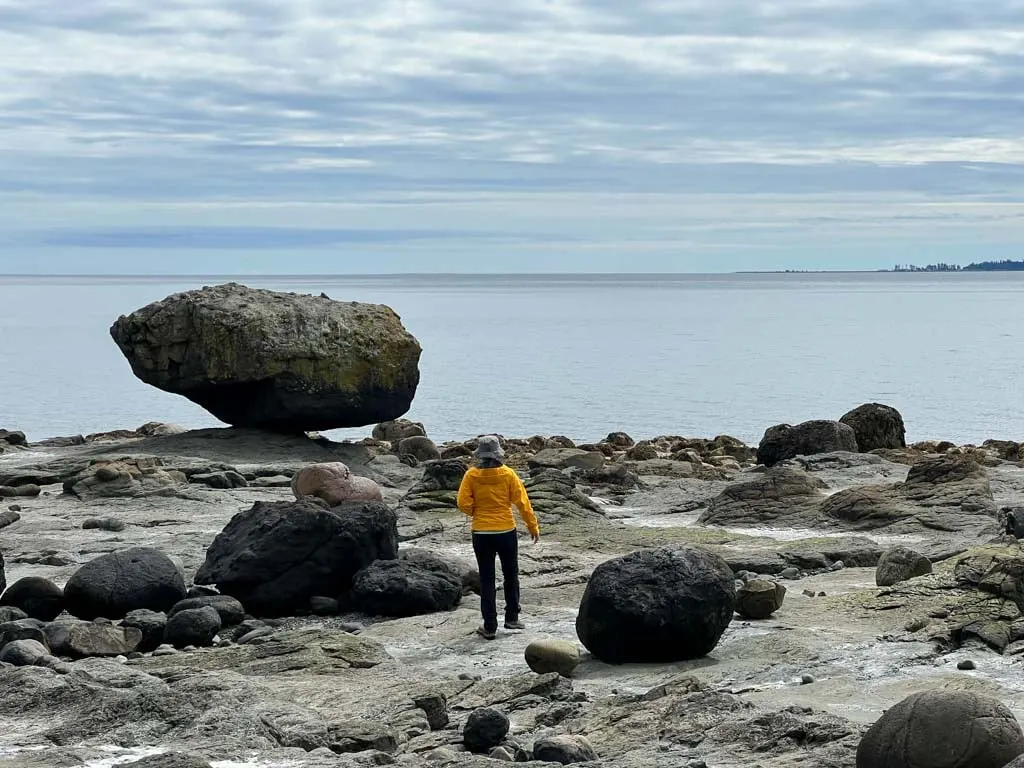
Given the rock’s position on the shoreline and proximity to the waves, it is surprising that it has stayed balanced for all these years! The rock makes for a fun photo op. You can find it via a short trail from the highway just north of Skidegate.
Golden Spruce Trail
Known as Kiidk’yaas in Haida, the Golden Spruce was a Sitka spruce tree with a genetic mutation that made its needles gold instead of green. The tree was illegally cut down in 1997 as a protest against the logging industry.
The tree was the subject of The Golden Spruce, a very popular 2005 book by John Valliant and the 2015 documentary Hadwin’s Judgement, which my friend Yves Ma helped produce. It’s a fabulous story and I recommend either reading the book or watching the film before coming to Haida Gwaii.
While the Golden Spruce is long gone, rotting back into the forest, the Golden Spruce Trail is still a nice short hike. The trail is located just outside Port Clements and leads through a beautiful old-growth forest to the banks of the Yakoun River. Beautifully carved interpretive signs provide info on Haida culture.
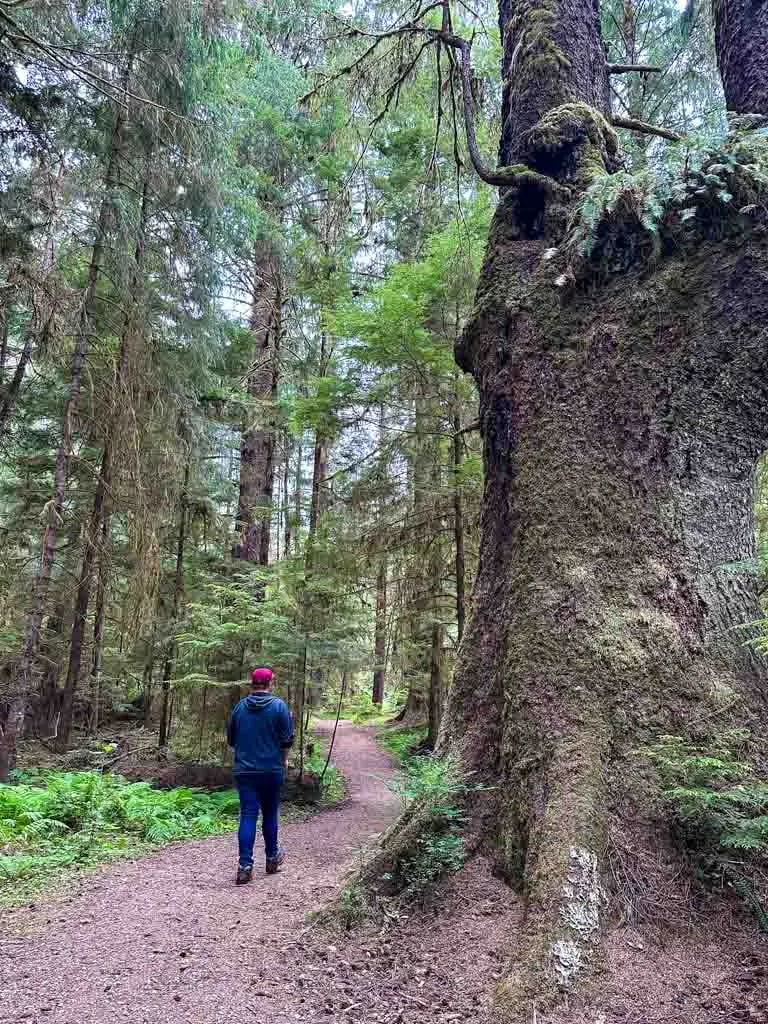
Delkatla Wildlife Sanctuary
If you visit in spring or fall, the Delkatla Wildlife Sanctuary near Masset is a must-see. It protects an intertidal wetland on the edge of town that is an important stop for migrating birds. There is also a Nature Centre where friendly volunteers can answer your questions.
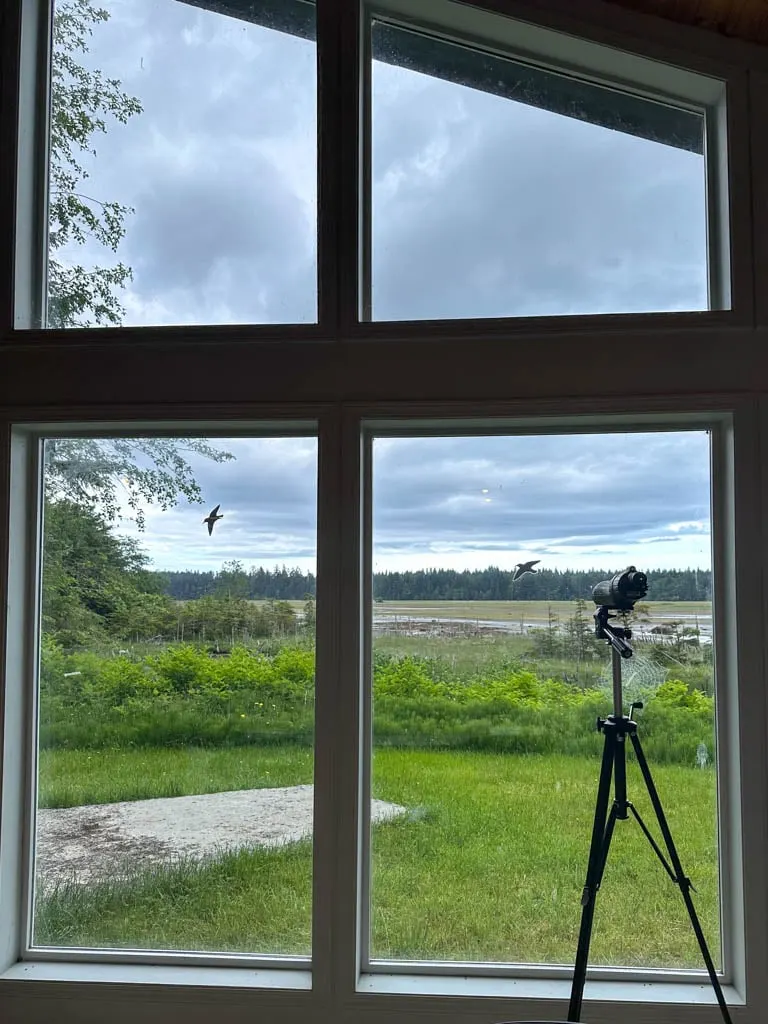
On my June visit most of the migrating birds had already left, but we were able to watch some huge sandhill cranes and their babies feeding. There are walking trails around the sanctuary as well as several viewing platforms.
Other Hikes on Haida Gwaii
Even though I spent 10 days on Haida Gwaii, I still missed out on some good hikes. Here are a few trails that are on my list for my next visit:
Anvil Trail: A short, flat, and reportedly muddy loop hike through beautiful old-growth forest near Tlell.
Sleeping Beauty/Tarundl Trail: A challenging trail near Daajing Giids that leads to the top of 1000m-tall Mount Raymond.
Mount Moresby: At 1,164, Mount Moresby is the tallest mountain on Moresby Island. It’s an all-day hike to the summit from logging roads south of Sandspit.
Kayaking
Haida Gwaii is famous for its kayaking. Experienced kayakers can launch boats and set out on an independent expedition, but most paddlers opt to go with a guiding company.
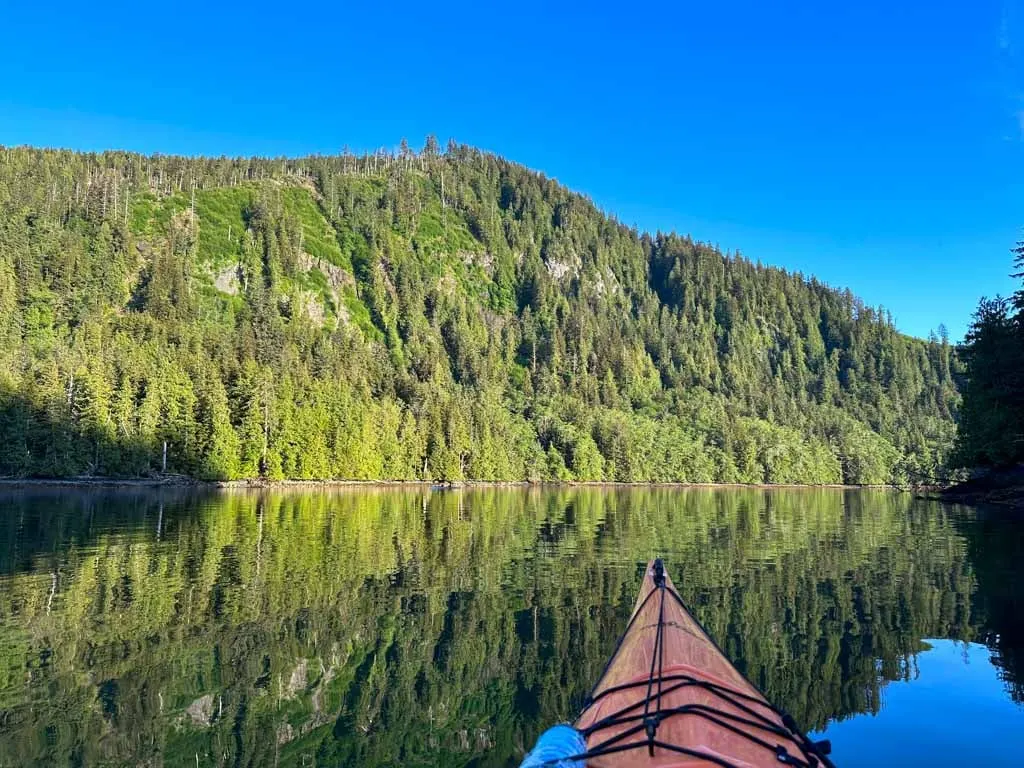
Most kayak tours paddle a portion of the coastline in Gwaii Hanaas National Park – the park is too big to cover on a single trip!
If I go back to Haida Gwaii, a multi-day kayak tour is at the top of my list. I’ll probably go with Butterfly Tours. They are the sister company of At the Water’s Edge Adventures. I had a great tour with them in the Johnstone Strait on Vancouver Island. Green Coast Kayaking is another local company that gets great reviews.
Camping
Haida Gwaii is a popular spot for camping. Many travellers bring their RVs or tents and spend a week or more camping around the islands. There are quite a few campgrounds to choose from and none of them require reservations. Here’s a run-down of the best places to camp:
Agate Beach: Located near the northern tip of Haida Gwaii in Naikoon Provincial Park, most of the sites are beachfront and have incredible views. We loved our stay here.

Misty Meadows: Also in Naikoon Park, this campground is close to Tlell and the Pesuta Shipwreck Trail. It’s also a short walk to the beach. We camped here after hiking to the wreck.

Haydn Turner Park: Find this town-operated campground just outside Daajing Giids on the west side of town. The campsites are all in the forest, but it’s a short walk to the beach.
Moresby Camp: Accessed via gravel roads from Sandspit, this is the launch point for tours into Gwaii Haanas National Park. Run by Sites and Trails BC, the campground has incredible views of Cumshewa Inlet.
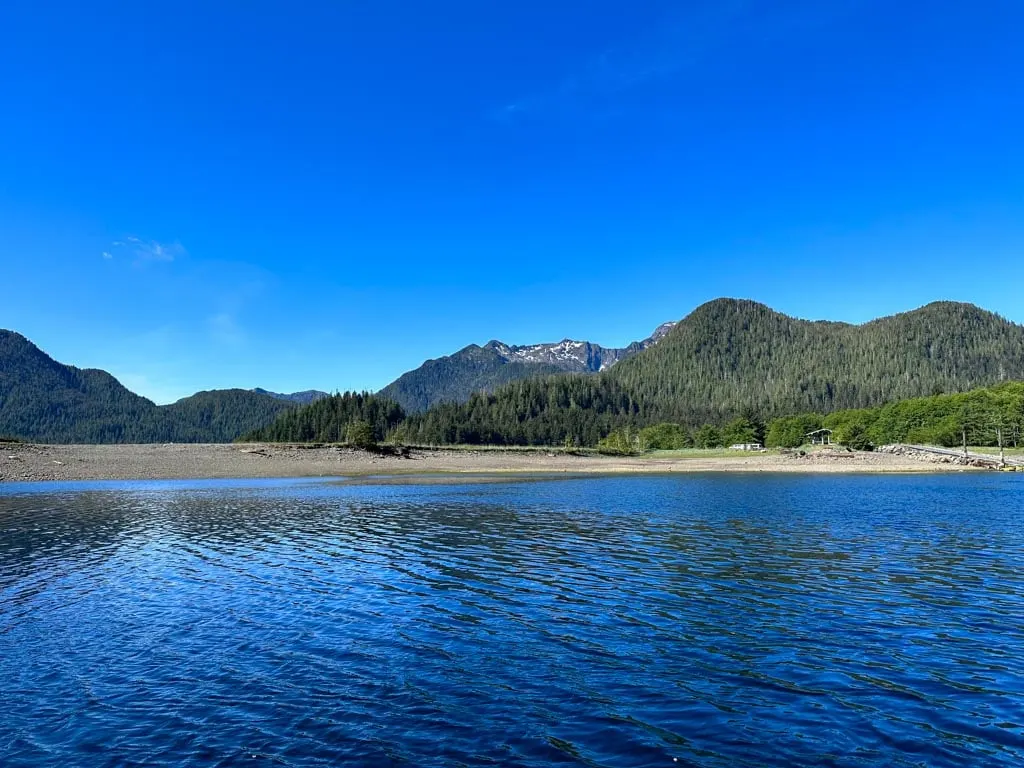
Other Campgrounds: There are several rustic campgrounds with few facilities accessed via gravel roads. Popular options include Kagan Bay near Daajing Giids, Mosquito Lake on Moresby Island, and Gray Bay on Moresby Island.
Fishing
Haida Gwaii is famous for its sport fishing. You can catch lingcod, halibut, and rockfish from mid-March to November. Salmon season is May to September for Chinook (King), Coho, Chum, Sockeye, and Pink Salmon.
You can book day-charters to go fishing in Haida Gwaii, but all-inclusive fishing lodges are also popular. I didn’t go fishing in Haida Gwaii, so I can’t recommend any particular company.
How to Get to Haida Gwaii
Haida Gwaii is a remote place. It’s 100 km off the northern coast of British Columbia. The only way to get there is to fly or take a ferry. I’ve got details on both below.
Ferries to Haida Gwaii
BC Ferries runs ferries from Prince Rupert on the mainland to Skidegate Landing on Haida Gwaii. The sailing takes about 7 hours. Be sure to make reservations well in advance if you are travelling with a vehicle because it sells out.
You can drive your car or RV onto the ferry or walk on. As of 2023, standard vehicles (under 20ft/6.1m) cost $154.10 and adults cost $43.45. Fares are slightly cheaper in the winter.
In the summer, there are six sailings a week. Most are daytime sailings, but there is one overnight sailing. In the fall, winter, and spring, there are three sailings a week, split between daytime and overnight sailings.
Most sailings are on the Northern Adventure. There is a cafeteria on board and you can book a cabin, which makes sleeping on overnight sailings much easier.

The crossing between Haida Gwaii and Prince Rupert goes through the Hecate Strait, which is very shallow. That means that rough water is common. The ferry has active fin stabilizers to make the voyage more comfortable. However, I recommend bringing seasickness medication just in case.
I took the ferry to and from Haida Gwaii and experienced sunny skies with calm seas. However, some of the people I met on my Gwaii Hanaas tour had taken the ferry a few days earlier and reported that many passengers were seasick.
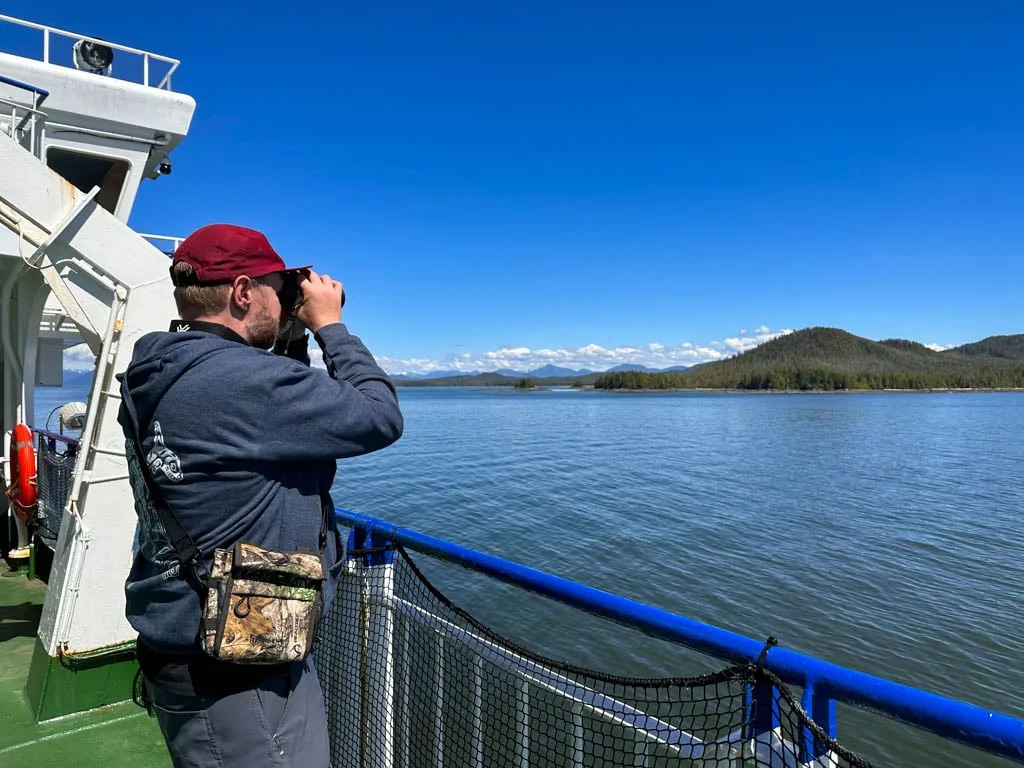
Getting to Prince Rupert
The city of Prince Rupert is the departure point for ferries to and from Haida Gwaii. The ferry terminal is 10 minutes outside of town.
Psst! I recommend spending a few days in Prince Rupert – there are so many things to do!
Prince Rupert is about 17 hours by car from Vancouver. It’s a beautiful drive through the interior of British Columbia on well-maintained highways.
However, I recommend taking the Inside Passage ferry, which is even more scenic. The Inside Passage ferry leaves from Port Hardy on northern Vancouver Island and sails up the coast to Prince Rupert. The voyage takes about 16 hours and is renowned for its beauty. Whale sightings are common – we saw lots on our trip!
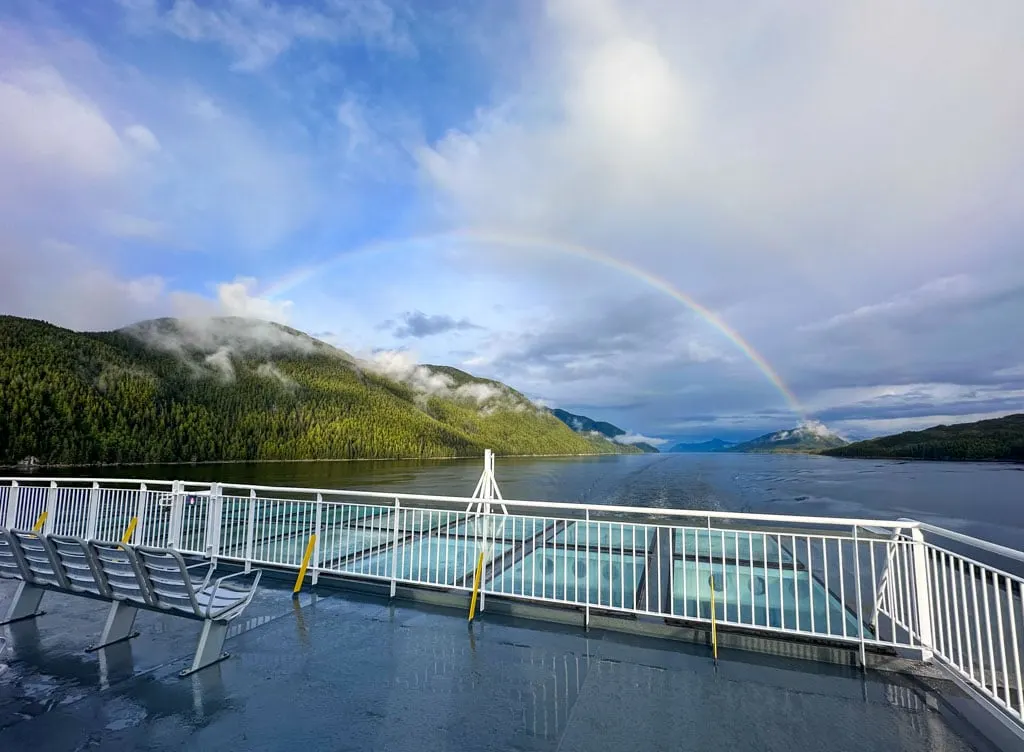
You can also fly to Prince Rupert from Vancouver, but it’s more efficient to fly directly to Haida Gwaii instead of taking the ferry to Haida Gwaii.
Flying to Haida Gwaii
Haida Gwaii has two airports: one at Sandspit on Moresby Island and one at Masset on the northern part of Graham Island.
Air Canada offers daily flights from the main terminal Vancouver International Airport to Sandspit. Pacific Coastal Airlines also offers daily flights from the south terminal of Vancouver Internal Airport to Masset. (The south terminal is a bus ride away from the main terminal.) Flights with both airlines cost $250-400 each way.
Inland Air Charters offers flights from Prince Rupert to Masset three days a week for about $320 each way. However, it only makes sense to take this flight if you plan to spend time in Prince Rupert. Otherwise, it’s easiest to fly from Vancouver.
Getting Around on Haida Gwaii
Haida Gwaii is not very big – there are only about 140 kilometres of paved highways and one ferry between the two main islands. With no public transportation on the islands, it’s easiest to drive yourself. Below I’ve got more info about rental cars, shuttle buses, taxis, and ferries.
Driving on Haida Gwaii
Driving is by far the easiest way to get around on Haida Gwaii. You can bring your own car on the ferry or rent one once you arrive.
It’s hard to get lost on Haida Gwaii since there are only 140 kilometres of paved highway and only one traffic light. Everything is well signed. The roads along the coast can be a little twisty, but they are easy to drive. Most roads are also fairly smooth.
There are also lots of logging roads and gravel roads on Haida Gwaii. Only two of the major attractions are on gravel roads: Tow Hill and the Golden Spruce Trail. These roads are well-graded for regular vehicle traffic.
If you plan to drive on other logging roads, drive with your lights on and go slow around corners. If you see a logging truck in front of you or behind you, pull over ASAP and let it pass – they have the right of way since they can’t brake suddenly. As well, read your rental agreement careful as many companies don’t allow logging road travel.
With poor cell coverage on most of the islands, you will need a map if you plan to venture off the paved roads. I recommend using the Gaia GPS app with the Backroads Mapbook layer. It shows all logging roads.
Renting a Car
There are several car rental companies on Haida Gwaii in Sandspit, Daajing Giids, Skidegate, and Masset.
Besides Budget Car Rental, all of the other rental companies are small local businesses. Some have online booking, but phone is best for most companies. And book in advance as they run out of cars in summer.
Most rental companies are located at the airport or offer a shuttle from the airport or ferry terminal to their office.
Keep in mind that you can’t take rental vehicles on gravel roads, as it will void your rental agreement. Some rental car companies have penalties (about $600) for driving off paved roads.
Rental car companies on Haida Gwaii include Budget (Sandspit and Daajing Giids), Island Auto Rentals – 250.559.4118 (Daajing Giids), Gwaii Adventure Campers (Daajing Giids), Gwaii Taxi and Tours (Skidegate), Masset Car and Truck Rentals (Masset), and Rustic Car Rentals – 250.626.3756 (Masset).
Taxis and Shuttle Buses
While Haida Gwaii has no public transportation, there are several local companies providing taxi and shuttle bus services. You can also book tours that include transportation between ferries, airports, hotels, and attractions.
Since Haida Gwaii is such a small place, the status of local operators changes often. It’s best to call and ask ahead of your trip to find out if shuttles or taxis will be available.
Local taxi and shuttle companies include Gwaii Taxi and Tours, Mile Zero Taxi, and Eagle Transit.
Ferries
There are two main islands in Haida Gwaii. Graham Island in the north is home to most of Haida Gwaii’s towns. Moresby Island in the south is where you will find Sandspit, but otherwise it is mostly undeveloped.
The only way between the two islands is via BC Ferries. The ferry goes between Skidegate Landing on Graham Island and Alliford Bay on Moresby Island. Alliford Bay is a 15-minute drive from Sandspit.
The ferry runs fairly often from early morning to late evening. Check the schedule carefully to make sure you don’t miss the last ferry of the day! The ferry does get behind schedule, but in that case, it will run on-demand, shuttling back and forth until the backlog is cleared.
The sailing takes 20 minutes and is on the Kwuna, which is an open-decked ferry that holds up to 16 vehicles. There is a small lounge for walk-on passengers, but most people stay in their cars.
You cannot reserve the ferry – it is first-come, first-served. As of 2023, standard vehicles (under 20 ft./6.1 m) are $22.20 and passengers are $9.55 each. Fares are return so you only have to pay when leaving Graham Island – you don’t have to pay if you are leaving from Alliford Bay.
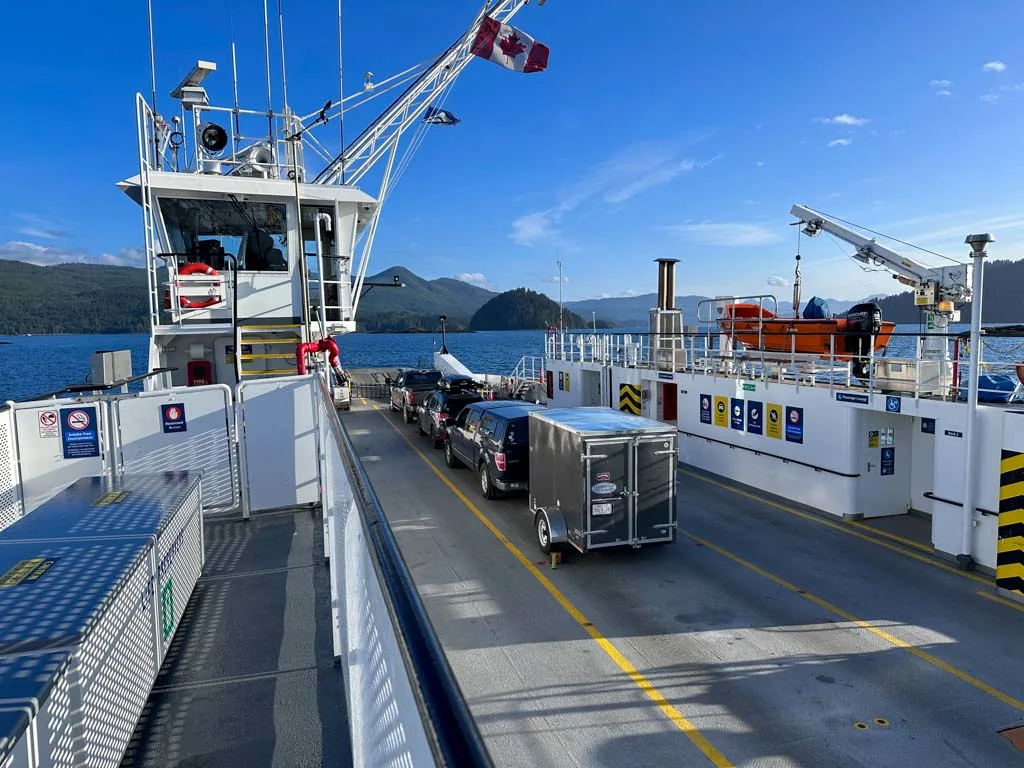
Best Hotels and B&Bs in Haida Gwaii
The first thing to know about booking a hotel or other accommodation in Haida Gwaii is that there aren’t very many places to stay. The second thing to know is that many of them don’t have a big online presence so be prepared to book by phone.
Below I’ve got picks for where to stay in various spots around the archipelago.
Where to Stay in Sandspit
Seaport B&B: We stayed at this basic B&B before our Gwaii Hanaas tour. It has a fun communal atmosphere and a great view of the beach from the front deck. Check rates.
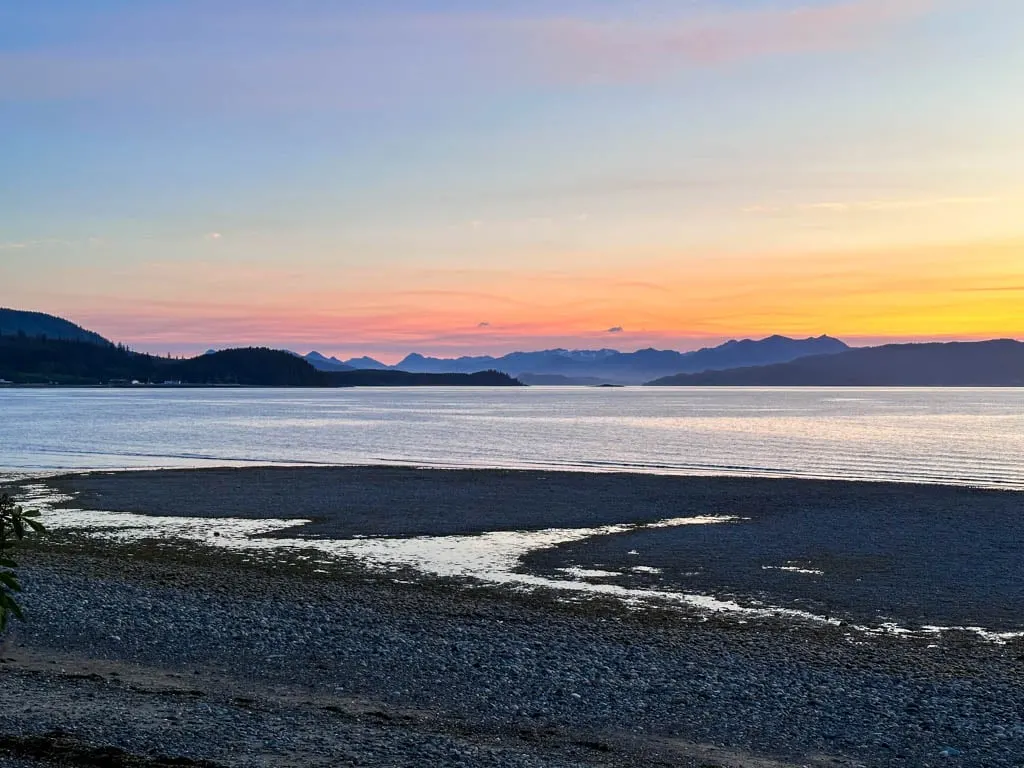
Hekate’s Retreat: A guesthouse nestled between an orchard and the gold course, a short walk from the beach. Check rates.
Where to Stay in Daajing Giids (Queen Charlotte)
Premier Creek Lodging: This is the oldest hotel in Haida Gwaii and a favourite for returning guests. It has a gorgeous garden alongside a creek. Check rates.
Spruce Point Lodge: The only waterfront hotel in Daajing Giids. It has motel-style rooms with breakfast delivered each morning. Check rates.
Where to Stay in Skidegate
Jag’s Coffee Shop & Guest Rooms: We loved our stay here! (We actually stayed twice – one night at the beginning of our trip and another night at the end.) It’s right next to the best coffee shop and bakery on the islands. The rooms are modern and clean. I think it’s the best non-luxury place to stay in Haida Gwaii. Check rates.

Where to Stay in Tlell
Haida House at Tllaal: This luxury resort is run by the Haida Nation and is the nicest place to stay in Haida Gwaii. You also have the option of booking an all-inclusive package that includes tours. Check rates.
Haida Gwaii Glamping Co.: Camp without roughing it at these adorable glamping tents which include bathrooms and decks. They are located right on the beach. Check rates.
Where to Stay in Port Clements
The Blue House: This funky two-bedroom vacation rental is right on the ocean and has great views from both the deck and the bedroom. The decor is also pretty fun. Check rates.
Where to Stay in Masset
Gwaii Naay Island House: Owned by the Haida Nation, this guest house is within walking distance of everything in Masset. It has a shared kitchen if you want to prepare your own meals. Check rates.
All the Beach You Can Eat: Fun off-the-grid cabins on North Beach in between Masset and Naikoon Provincial Park. Each cabin was hand-made out of custom-milled driftwood. Check rates.
Best Restaurants in Haida Gwaii
Just like with hotels, there aren’t that many restaurants in Haida Gwaii. As well, many are open only a few days a week. To avoid disappointment, call ahead to confirm hours and make a reservation.
There may be some days when there are no restaurants open in a town. Make sure you visit the grocery store and stock up on snacks or ready-to-eat foods just in case.
Sandspit
The Clubhouse at Hekate’s Retreat: They have a great patio overlooking the golf course. My friends said they had a great dinner here and the burgers were good. Note: This is often the only place open for dinner in Sandspit.
Daajing Giids (Queen Charlotte City)
The Village Hearth: I loved my dinner at this small restaurant. They have a small and eclectic menu that seems to change often and draws from many different cuisines. I had Korean-style beef shortribs that were amazing. They also have great cocktail options. Ask for a patio table to enjoy the view.
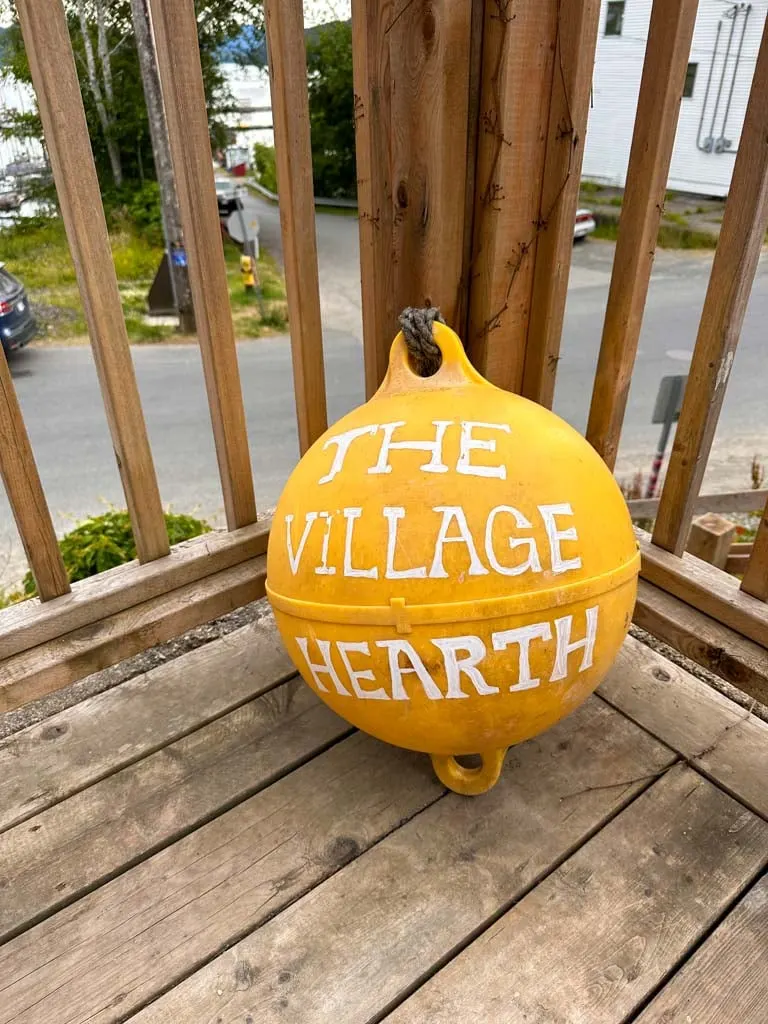
Blacktail: The food here was really well executed and much higher end than I expected to find in Haida Gwaii. I had some incredible mushroom pasta and my husband loved the pork loin. Order their sourdough focaccia to start – sooo good.
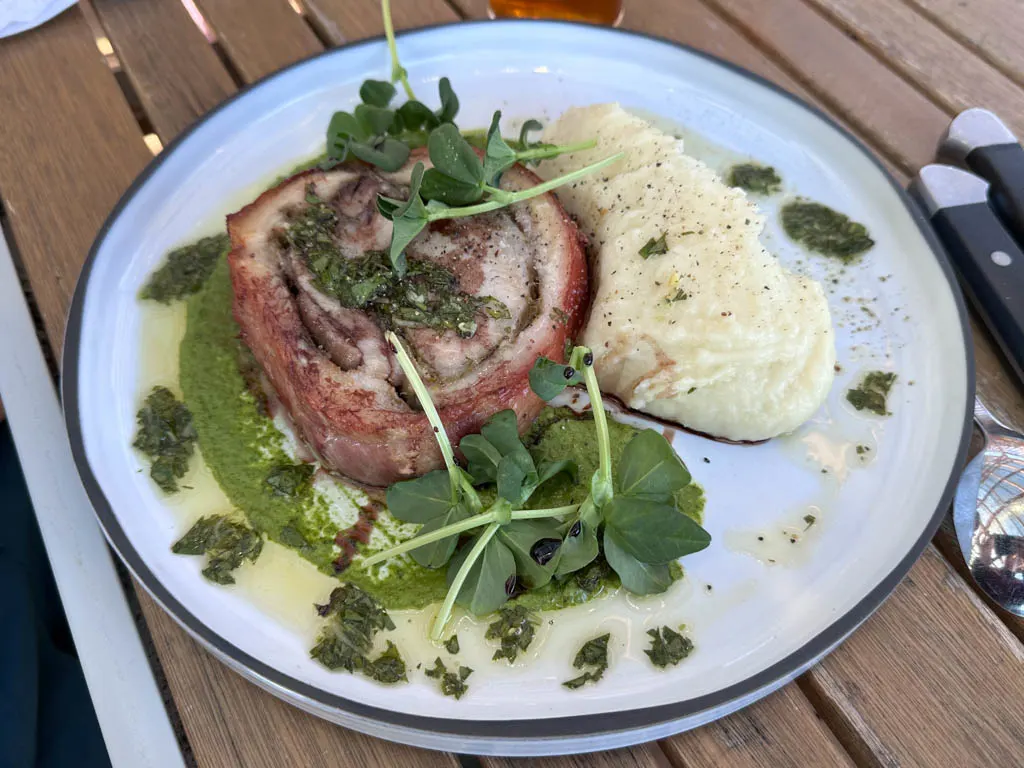
Gather: We didn’t call early enough to get a table at Gather, but we heard so many good things about it from locals and other travellers. They have an Italian-influenced menu that looks really tasty.
Skidegate
Jag’s Coffee: We loved Jag’s so much that we ate there three times! They have the best coffee on Haida Gwaii along with great baked goods. I also loved their breakfast and sandwiches. My fave was the pastrami bagel.
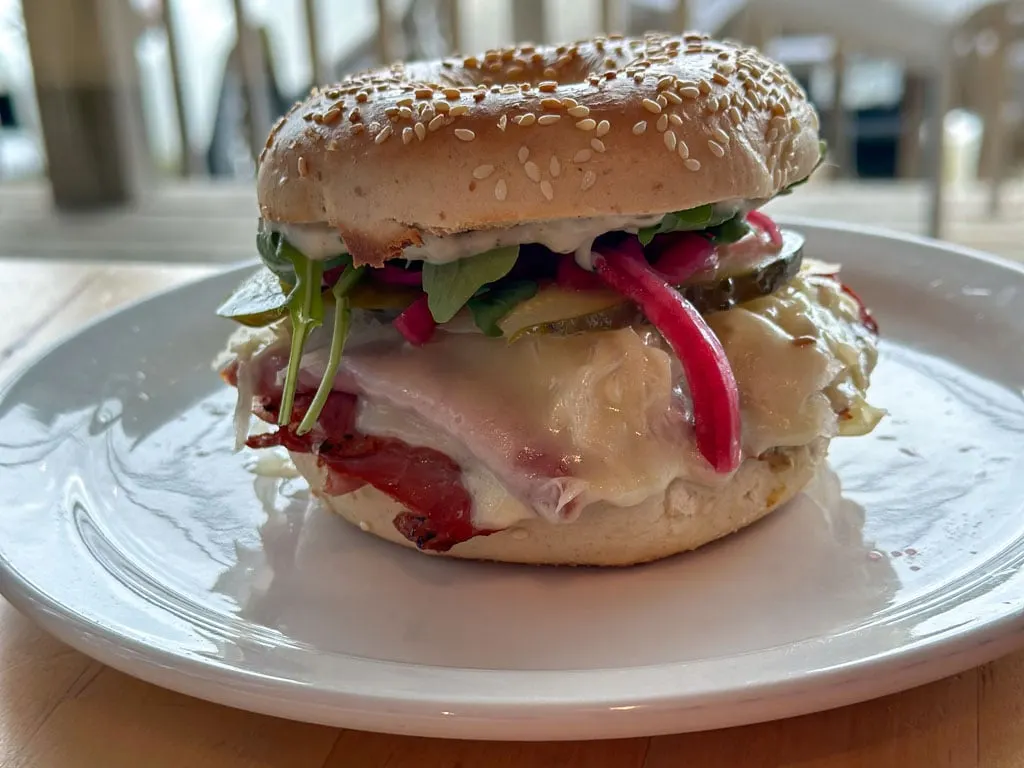
Keenawaii’s Kitchen: I wish we had booked a table in advance because I’m sad we didn’t get to eat there. Chef Roberta Olson makes traditional Haida meals using local, wild-harvested ingredients. It sounds amazing!
Tlell
Haida House at Tllall: Make a reservation in advance to eat at this high-end restaurant. We didn’t eat here, but other travellers told us that the seafood was delicious.
Port Clements
The Axe & Anchor Pub: This is a great pub with an incredible patio. The food was pretty standard for pub food, but well executed and the service was really friendly. I had a great quesadilla and my friends said the burgers were great.
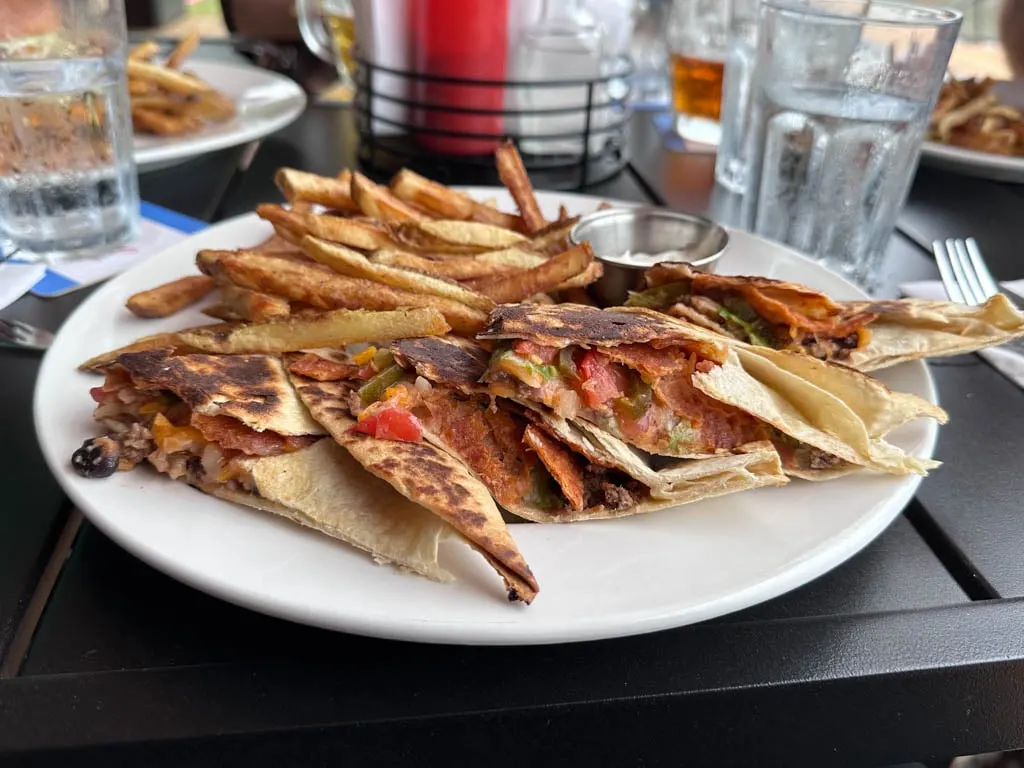
Masset
The 626: Located right across from the Coop grocery store, this little restaurant is a small building, food truck, and deck cobbled together. But it’s worth a visit for the best fish and chips in Haida Gwaii. They also have fish tacos, pizza, and delectably thick milkshakes. (Their name comes from the fact that most phone numbers in Masset start with “626”.)
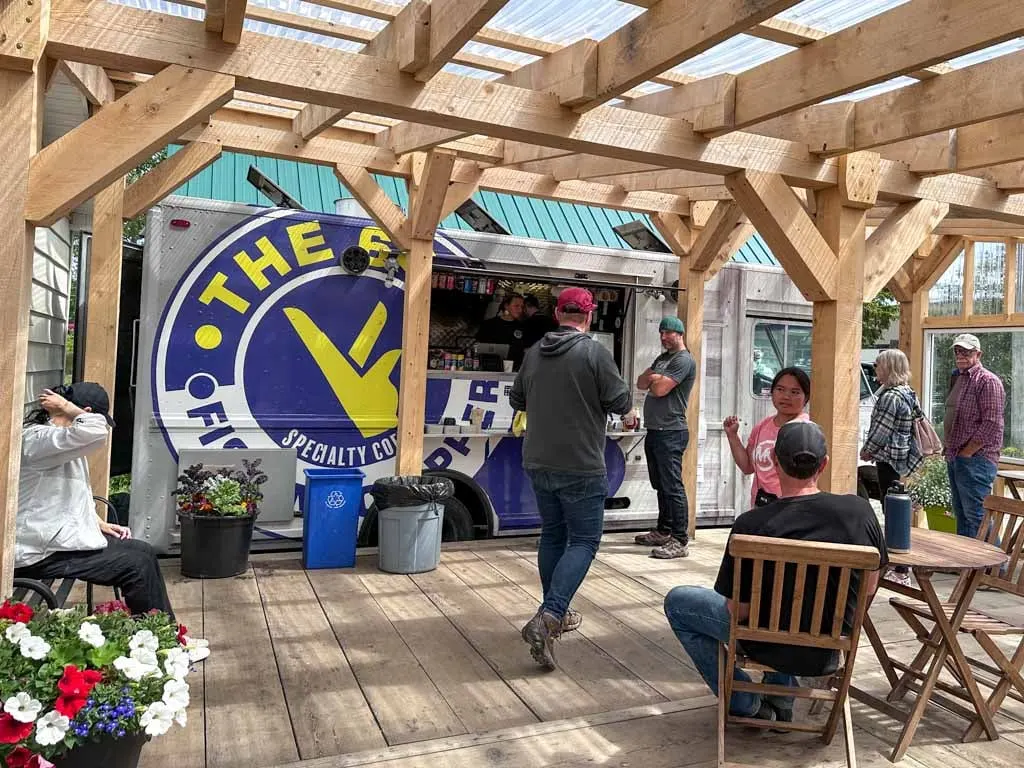
Tips for Visiting Haida Gwaii
Visiting Haida Gwaii was the trip of a lifetime for me, and that’s the case for a lot of people. I did a lot of research before I went, but there were still a few surprises. Here are my top tips for visiting Haida Gwaii:
- Make ferry, flight, tours, restaurant and accommodation reservations well in advance. There is limited availability and things get booked up.
- If you want to wing it a little, plan to camp. There is lots of camping available, you don’t need to make reservations, and it doesn’t seem to fill up.
- Check restaurant and grocery store opening hours carefully. Most places are only open for a few hours each day and some are only open a few days a week. Call businesses to confirm because business hours listed on Google often aren’t correct.
- Pack warm and waterproof clothing. Haida Gwaii’s climate is wet and a little chilly, even in summer.
- Stop into the visitor centres at Daajing Giids, Masset, or Sandspit. They can help you plan your trip and answer questions. You can also pick up a copy of This is Haida Gwaii, the annual tourist brochure. It has great maps and a helpful section on the monumental poles you can see around the islands, including an explanation of the carvings on each one.
- Learn a bit about Haida culture before you arrive to be respectful. There is a good suggested reading list and other info on the Take the Haida Gwaii pledge website. Listen carefully when Haida people speak – we are visitors on their land.
- Ask before taking pictures of Haida poles, art, and buildings, especially when taking pictures of people. Photos are allowed in most places, but it’s polite to ask first.
- Many visitors don’t realize that many monumental poles (commonly called totem poles) are actually memorial poles, raised to mark someone’s death. Give these poles the same respect you would give a graveyard or other memorial.
- Remember to say haw’aa (thank-you in Haida) to everyone you meet.
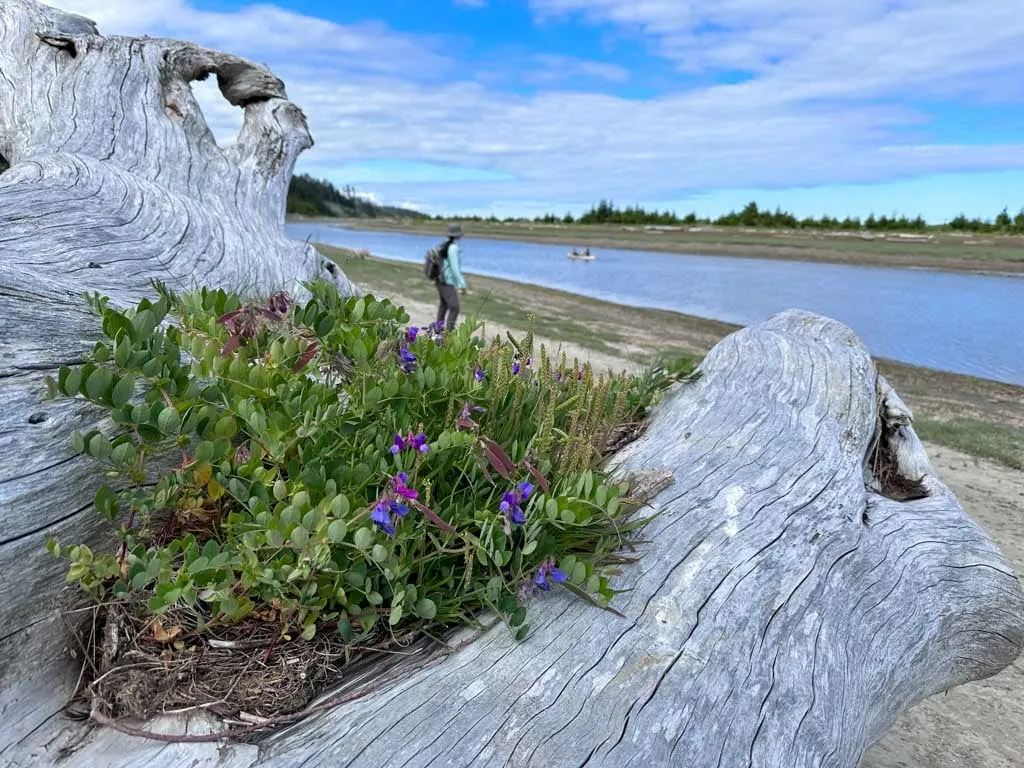
So that’s everything you need to know to plan a trip to Haida Gwaii. I hope you enjoy your trip as much as I loved mine. I just need to figure out when I can go back!
READ NEXT:
- The Ultimate Guide to Gwaii Haanas National Park Reserve
- Tow Hill and the Blow Hole Hike in Haida Gwaii
- Pesuta Shipwreck Trail in Haida Gwaii
- 20+ Things to do in Prince Rupert, BC
- Inside Passage Ferry from Port Hardy to Prince Rupert, BC
- Things to do in the Nass Valley (Nisga’a Territory) in Northern BC
- Things to do on Northern Vancouver Island
- Where to Experience Indigenous Tourism in Canada
- 2025 Altitude Sports Black Friday Sale: My Picks for the Best Deals - November 25, 2025
- Bowron Lakes Canoe Circuit: 2026 Paddling Guide - November 20, 2025
- 2026 BC Backpacking Reservation Dates You Need to Know - November 20, 2025

